The 8-Step Problem-Solving Method
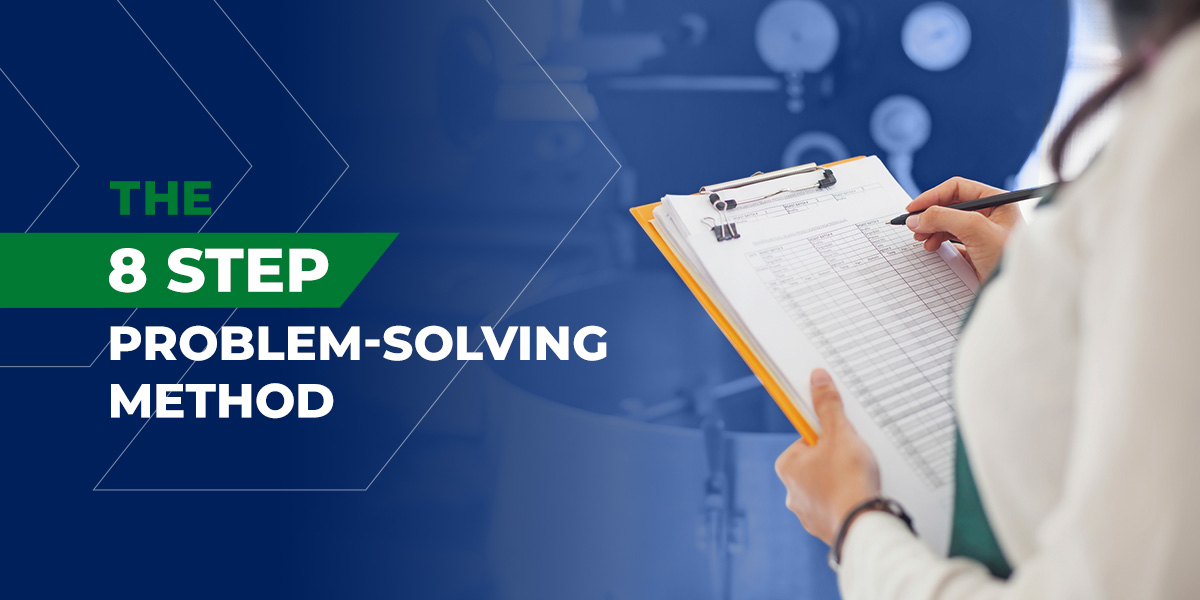
- November 22, 2021

Table Of Contents
What is the 8-step problem-solving method, the 8 steps and the problem-solving process, the culture of problem-solving.
- Plan, Do, Check, Act (PDCA)
- Gain Problem-Solving Support
As a manufacturing professional, you know how important it is to stay organized, keep your goals in mind and strive for success. But with all of the responsibilities and daily tasks piling up, it takes effort to find and stick to a process that can keep you on track.
Luckily, there’s a tried and trusted way to achieve success in the manufacturing industry.
The eight-step problem-solving process is a structured method that guides you through the various steps of solving issues. Unlike other problem-solving processes that are often broad, the eight-step method takes you through each individual step, from identifying the problem to taking actionable steps to success.
Instead of changing a few things at a middling level that will probably break down again later, you can unearth the roots of problems and build success from the ground up.
For a fundamental breakdown of how to fix problems and lead your manufacturing team to success, here are the eight steps of the problem-solving process.
1. Identify the Problem
The first step in the process is to identify the problem. Identify why this is a problem, how you discovered it and how it impacts your business. Also note when the problem started and how long it has been going on.
If the problem is small, you can try to contain it and may not need additional steps to fix it. However, if the problem is complex, move forward through the process.
2. Define the Problem
The next step involves breaking down the problem and defining what it is. It’s important to be as clear as you can with this step — a vague problem will hinder the process, whereas a clearly defined issue will allow you to take actionable steps to fix it.
Analyze factors like how high of a priority it is to solve the problem. You can also look to data and other resources to clarify or help you understand the concern.
3. Make a Goal
Create an end goal. Envision what fixing this problem would look like and feel like. What would it accomplish? How would it help you? Map out all the ways fixing this problem would benefit you and use it for motivation to achieve your goal. Set a timeline to figure how long it will take to accomplish that goal.
4. Find the Root of the Problem
Often problems are byproducts of deeper, more central problems, so make sure you dig deep enough to find out what is really causing the issue. If the problem is large and complex, break it down into individual parts.
Gather information and use it to identify the deeper issues of the problem and validate what you think the real concern may be. Take time at this step to really focus on the deep problem — executing this step effectively will save you a lot of time down the road.

5. Develop Actionable Steps
Create a list of realistic steps you can take to combat the problem. You can start with a large list and combine or subtract steps, but it’s important you come up with various ways to attack the problem. Use this action plan to draw up a strategy to get at the root of the problem. Each step should be specific and detail-focused — any steps that are vague or tedious will only take up time and cause confusion.
6. Execute Steps
Now that the plan is in place, all you have to do is follow through on your actionable steps. Illustrate the steps you’re taking to your team, explain why you’re taking them and delegate any steps that another employee has to perform to execute your plan.
Communication is key in this step. In most cases, you won’t be executing the plan all by yourself, so make sure you’re expressing the goals and motives of each step with your team so they can see how it connects to the bigger picture.
7. Observe and Evaluate
Monitor your strategy carefully and see how it relates to the original problem. Is it working? Is it only creating more problems? Gather data, talk to your team and be thorough and objective in your evaluation. You might have to readjust your plan as you gain new information, or you may meet your goals and the plan will be successful.
8. Continue the Process
If the plan worked, find ways to continue integrating these steps into your team’s daily routine. If they didn’t work, go back to the goal-setting process or identify some more aspects of the problem — there may be a deeper concern you missed the first time around. Communicate to your team about how the plan went.
In the future, continue using the eight-step process to solve issues and build momentum with your team.
It’s important to build a culture of problem-solving in your manufacturing plant. It can be easy to fall into the trap of “Band-Aid” solutions — quick fixes without digging into the deeper problems.
It’s believed that the eight-step problem-solving process was actually created by the Toyota Motor Corporation to achieve their admired production standards.
From the lore of Toyota, we get some great eight-step problem-solving examples. Taiichi Ohno , the father of the Toyota Production System, observed his workers fixing only the first level of cause when their machines stopped working. To combat this, he developed a problem-solving method to methodically break down each problem of the machine until he found the root cause. Only then could he truly fix the machine.
It’s one of many eight-step problem-solving examples, and it shows the importance of creating a process to increase productivity.
Plan, Do, Check, Act (PDCA) and the 8-Step Problem-Solving Process Differences
The eight-step problem-solving process is an expanded version of the Plan, Do, Check, Act cycle . The first five steps of the 8-step process fall under the planning step, while steps six, seven and eight all correspond to the do, check and act steps. The eight-step process is a more detailed, methodical version of PDCA problem-solving, and converts a vague cycle into something a bit more specific and actionable.

Gain the Problem-Solving Support You Need With MANTEC
MANTEC is the best resource center for manufacturing companies in South Central Pennsylvania. We’re a non-profit that solves any problems a manufacturing facility could have, including sales and marketing , process improvement , manufacturing technology and workforce engagement .
Our expert staff has had vast experience in the manufacturing industry, and we can provide the guidance you need to get your business running at top efficiency. Our services are affordable and extremely valuable. Contact us today!
Related Posts

Struggling to manage multiple payment systems for different business needs (B2B, B2C, D2C)? Payment Hub…

In the dynamic landscape of business, achieving and maintaining an International Organization for Standardization (ISO)…

Manufacturers need to build agility into their businesses and processes to respond and recover faster…

8 Steps to Problem Solving: Implement Continuous Improvement in Your Organization
The 8 Steps to Problem Solving Method was developed by Toyota Motor Corporation as a practical, structured, and simple way to handle any problem from the smallest issue to the most complex roadblock.
What is the 8 Step Problem Solving Method?
This problem-solving method helps teams identify and solve problems in a clear and structured way, ensuring that there is consistency within an organization.
This process is an expansion of the Plan, Do, Check, and Act (PDCA) cycle. Steps one through five are part of the planning process, step six is the doing process, step seven is the checking process, and step eight is the acting part of the cycle.
Following this method ensures that your problem-solving technique can be repeated in a sustainable way with the least amount of impact on your customers.
What are the benefits of the 8 Step Method?
There are a few key benefits to using this method to solve your problems:
You get to the root cause of the issue, ensuring the problem is not repeated in the future.
You can better identify and prevent any weak points in your process.
Long-term, effective solutions are generated.
Problems will be reduced over time, increasing your bottom line.
What are the 8 Steps in this Methodology?
Clarify Problem
Break Down Problem
Root Cause Analysis
Develop Countermeasures
See Countermeasures Through
Monitor Results and Processes
Standardize Successful Process
A Detailed look at the 8 Steps to Problem Solving Templates

Step 1: Clarify The Problem
In this step, you need to identify and clarify the problem. Determine why it is a problem, what should be happening instead, and how it fits into the business as a whole.
The Stormboard Template for this step is divided into four sections: Clarify Ideal Situation, Clarify Current Situation, Visualize Gap Between Current and Ideal Situations, and Set Ultimate Goal.
Step 2: Break Down The Problem
For this next step, you need to start getting more detailed and specific. Break down the problem into manageable pieces, go see the problem in the process, analyze the issues, and start thinking about priorities.
The Stormboard Template for this step is divided into three sections: Get Your Boots On and Go See, Create a Process Flow, and Identify Point of Occurrence.
Step 3: Set Your Target
This step is where you set clear target dates to resolve the problem. Determine what is needed to reach the target and how long it will take.
The Stormboard Template for this step is divided into three sections: Measurability, Target Point of Occurrence, and What, How Much, and When.
Step 4: Perform a Root Cause Analysis
In this step, you really dig into the factors that are causing the problem. Consider and address all of the causes of the issue — there will usually be more than one.
The Stormboard Template for this step is divided into four sections: Create a Decision-Making Tree, Analyse and Discard Ideas, Ask Why, and Conduct “Why Analysis”.
Step 5: Develop Countermeasures
Use this step to brainstorm countermeasures that will help you remove the root causes of your problem. Come up with as many as possible, and then narrow the criteria matrix and create an implementation plan
The Stormboard Template for this step is divided into three sections: List Root Cause, List Countermeasures, and Chart and Rate Countermeasures.
Step 6: See Countermeasures Through
In this step, you will implement your countermeasures using a clear plan and share the progress of each countermeasure that you implement with your team.
The Stormboard Template for this step is divided into three sections: Implement Countermeasures, Share progress, and Next Steps.
Step 7: Monitor Results and Processes
Use this step to determine if your countermeasures were successful or if they need to be adjusted and reimplemented.
The Stormboard Template for this step is divided into three sections: Evaluate Results, Report, and Lessons Learned.
Step 8: Standardize The Successful Process
In this step, you will integrate your successful countermeasure into your process, share your results with your team, reflect on what you have learned, and make sure there are no unaddressed issues.
The Stormboard Template for this step is divided into three sections: Standardize, Share, and Start a new Kaizen.
See the template →
Are you interested in trying out Stormboard’s 8 Steps to Problem Solving Templates with your team? Sign up for a FREE trial now !
Keep reading.

A Retrospective meeting (or Retrospective sprint as it is sometimes called) is a step in the Agile model that allows for teams to take an overall look at what they have done over a period of time — a week, a month, etc. — to determine what’s working for them and what’s not.

Get free Save the Cat and 5-act beat board templates with Stormboard! Simplify your writing process with unlimited space, seamless collaboration, and easy recovery of discarded ideas. Perfect for novelists and screenwriters, our templates help you map out your story visually and clearly.

Discover the unspoken challenges faced by developers in agile teams. This blog reveals the core issues beyond common complaints, helping scrum masters improve team dynamics and productivity.

Explore the counterintuitive idea that even well-functioning teams with solid brainstorming sessions can benefit from AI. By playing the role of the devil's advocate, AI can introduce healthy disagreement and challenge the status quo, potentially leading to groundbreaking ideas.

If your Agile team uses the Scrum methodology, you are probably already practicing Daily Standup meetings (or Daily Scrum meetings). These meetings are an essential part of Scrum that should be done to keep the process on track. What is…

Enterprise organizations who have adopted the highly-effective Agile PI Planning strategy, have recently been forced to do their planning sessions remotely…

By definition, the word Agile means the “ability to move with quick, easy grace.” While this is how most of us would define Agile, the term has grown over the years to have a much more diverse, broad meaning — especially in the business world.

In today's evolving work environment, creating agile teams can change the face of team building in the modern workplace. Learn more about how you can manage your agile teams easily - whether you are in office, remote, or hybrid.

Explore the hidden costs of excessive meetings in Agile environments and learn how to streamline your team's workflow for optimal productivity. Discover practical solutions to common complaints and transform your meetings into valuable assets that drive efficiency and collaboration.

Discover the latest advancements in StormAI, the industry's first augmented intelligence collaborator, with exciting updates that enhance its capabilities. Learn about the innovative features and improvements that make StormAI 2.0 a groundbreaking technology for collaborative work.

Discover the contrasting views within the Agile community regarding spilled stories (or spillover) in sprint cycles and delve into strategies adopted by different teams. Gain insights into the pros and cons of each approach to better inform your Agile methodology.

Uncover the pivotal role collaborative platforms play in facilitating a seamless transition towards sustainable energy solutions. From project management to real-time communication, explore how these tools are reshaping the landscape for utility companies amidst the push for renewable energy adoption.
How Collaborative Leadership is Changing Business
Scared of the blank page add sample content to your template to get to work faster.
The PDCA Cycle (30+ Plan Do Check Act Examples)

In today's busy world, everyone is looking for simple ways to do things better and faster. Enter the PDCA cycle. It's like a four-step dance for making things work smoothly.
The PDCA cycle is an improvement cycle that involves four steps: Plan, Do, Check, and Act, to help improve any business process or task.
If you want to make your work more organized or solve problems more efficiently, the PDCA cycle can be your go-to tool.
Introduction to the PDCA Cycle

The PDCA cycle is a tool that helps with project planning. It breaks down a process into manageable steps, helps you test them, and adjust to get better results.
The cyclical nature of PDCA is a simple guide to help groups and companies work better and keep improving.
It's not just a one-time thing. This PDCA model is like a circle that keeps going, helping you learn and grow. By going through the steps again and again, you can stay up to date and keep making things better.
Even though it started in factories with quality control, the PDCA cycle is now used everywhere—in hospitals, schools, tech companies, and even for personal goals. It's easy to use, and you don't need special training or tools. You just need to be ready to try new things and keep improving.
Brief History of PDCA
The origins of the PDCA cycle trace back to the early 20th century. A man named Walter Shewhart , often called the 'father of statistical quality control,' introduced the idea.
Shewhart was working in the world of manufacturing, seeking ways to make production more efficient and error-free. Remember, this was a time when factories were booming, and any way to save time or reduce mistakes was super important.
Building on Shewhart's thoughts, Dr. W. Edwards Deming further used the plan do check act cycle for something new in the mid-1900s.
Deming's work specifically dealt with rebuilding Japan's industry after World War II . He realized that for industries to succeed, they needed a simple and strong framework. And he favored the PDCA cycle as a means of problem solving and continuous improvement.
It's because of these two people who helped create the process that it's sometimes called the Deming Cycle, Deming Wheel, or Shewhart Cycle.
So, why should you care about this history? Because understanding where the PDCA cycle came from helps in appreciating its value. It's not just a trendy buzzword; it's a tested and proven method that's been helping businesses for almost a century.
4 Steps of the Plan Do Check Act Cycle
Simply put, the four stages or steps are: Plan, Do, Check, Act. In a way, this is project management plan that not only improves management practices but also eliminates ineffective elements.
This is the planning stage—the time you think and plan. You find a problem or a chance to do something and decide what you want to achieve. Basically, you set up project goals and potential solutions to business problems.
Now, it's action time. Do the plan you laid out in the previous stage. But don't just rush in! It's important to do this on a smaller scale first, like a pilot test. Consider it a 'trial run'. This way, you get to see how things work without fully committing.
After you've taken action, you pause and assess. You're looking back at the results of your 'Do' phase. Did it go as planned? Were there unforeseen hiccups? This is your moment of reflection. Remember, there are problably multiple solutions to any problem, so if this plan didn't work, you can try a new one.
Sometimes this method is called plan do study act, instead of plan do check act. So you can think of this as the time to study the data.
After looking at the results from the 'Check' step, you make changes. If things worked, you can do more of it. If not, you fix and improve. After making changes, you start the cycle again with 'Plan'.
In essence, the PDCA cycle is an ongoing journey of improvement. It's all about learning, repeating, and progressing.
The Importance of Continuous Improvement

The heart of the PDCA cycle lies in the principle of continuous improvement . In today's ever-evolving world, standing still is not an option. You either move forward, or you risk falling behind.
Continuous improvement isn't about chasing perfection. It's about the journey of getting better every day. It’s acknowledging that no matter how good a process or product is, there's always room to do better.
Here’s why it is crucial to continuously improve:
1. Adapting to Change : Just like seasons change, so do markets, customer preferences, and technologies. By continuously improving, you ensure that you're not left behind.
2. Efficiency and Productivity : Improving business processes means eliminating wastes and unnecessary steps. This results in faster outputs with fewer resources.
3. Employee Satisfaction : Believe it or not, people like being part of a system that gets better. It boosts morale and engagement. When employees see their feedback being used to make positive changes, they feel valued and involved.
4. Customer Satisfaction : Continuously improved products or services translate to happier customers. By showing that you’re committed to betterment, you not only keep loyal customers but also attract new ones.
5. Long-Term Success : Think of continuous improvement as investing in the future. Small enhancements today can lead to significant benefits in the long run.
Use-Cases of the PDCA Cycle
Let's shift our gaze from the theory of PDCA to its real-world applications. The plan do check act cycle is not limited to big businesses or specific industries; it can be used by anyone who wants to continuously improve processes.
In hospitals, patient care is the most important. By using the PDCA cycle, hospitals can make patient admissions easier, improve treatment plans, and perform better after-care procedures.
For example, if a hospital notices long wait times in the emergency room, they can Plan a strategy to make it better, Do a trial run with the new system, Check the results, and then Act to put the plan into place everywhere or change it based on the feedback from the trial run.
Schools and colleges are always looking for ways to improve student learning and involvement. The PDCA cycle can help with curriculum design, classroom management, or even in creating better ways for students to give feedback.
A school might notice students struggling with online learning. They can then make a plan to offer additional resources, test it out with a group, assess the results, and change accordingly.
Tech Startups
In the tech world, you need to keep up with changes. Startups can use the PDCA cycle to make better products, improve user experience, or market better.
Think of a new app with problems after it's launched. The company can make a plan to solve it, try the fix, see what users say, and then improve it for the desired outcome.
Personal Goal Setting
Beyond organizations, individuals can use the PDCA cycle for personal development. Whether it's fitness goals, learning a new skill, or financial planning, this cycle can be a guide.
Suppose you set a goal to read more books. You plan by setting aside time each day, try it out for a week, check if you're consistent, and then adjust based on challenges or insights.
Manufacturing
PDCA started in factories, and they can gain a lot from it. It can help improve products and make production faster.
If a factory finds more faulty products, they can use the PDCA cycle to find the problem, try fixes, see what works, and then use the best solution regularly.
Starting Your Own PDCA Cycle: Step-by-Step Guide

Let's walk through how you can start your own PDCA journey.
1. Identify a Challenge or Opportunity : Every journey begins with a destination in mind. Look for an area in your organization, project, or personal life that needs improvement or has potential for growth. It could be as simple as improving morning routines or as complex as recreating a product line.
2. Gather Data : Arm yourself with information. Understanding the current situation helps in setting realistic goals. If sales have dropped in your business, get numbers. How much? Since when? Any patterns?
3. Set Clear Objectives : Define what success looks like. If you're addressing the sales drop, decide on a target percentage increase. Be specific. Instead of saying "increase sales," aim for "increase sales by 10% in the next quarter."
4. Brainstorm Solutions : Think of strategies to meet your objective. If it's about sales, maybe you need better marketing, more training for the sales team, or even a new product feature.
5. Pilot Test : Remember the importance of the 'Do' phase being a trial run? Implement your solution, but start small. This reduces risks. Using our sales example, maybe first train a small sales team with a new technique and see how it works.
6. Evaluate Results : Once your pilot is done, check the outcomes. Did sales improve for the team that received new training? By how much? Were there any challenges?
7. Implement or Adjust : Based on your evaluation, take action and implement change yourself. If the new sales training worked well, roll it out for everyone. If not, revisit your strategies, adjust, and test again. This is the act phase.
8. Document Everything : Keep a record of your entire PDCA process. This not only helps in future cycles but also creates a way for your team to look at what worked, what didn't, and make incremental changes in their process improvement.
9. Loop Back : The PDCA cycle isn’t a one-time thing. After 'Act', circle back to 'Plan'. Maybe after addressing sales, the next cycle focuses on having your customers came back again and again.
10. Celebrate and Reflect : Lastly, every time you complete a cycle, take a moment to acknowledge the progress. Celebrate wins, no matter how small. And always reflect on lessons learned for future cycles.
Common Mistakes and How to Avoid Them
The Shewhart cycle is an iterative process. In other words, it's a continuous process improvement.
But, just as a juggler learns best from dropped balls, understanding common mistakes in the PDCA cycle can prepare you to avoid or address them before they happen.
1. Skipping the Planning Phase : In eagerness to act, it's tempting to jump straight into action. But remember, a house built on shaky foundation won't stand for long.
Strategy : Always invest time in thorough planning. This phase sets the tone for the entire cycle.
2. Ignoring Data : Operating on gut feelings or assumptions can lead you down the wrong path. The PDCA cycle relies on data-driven decisions.
Strategy : Consistently gather relevant information. Then analyze it. Let numbers guide your actions.
3. Setting Vague Objectives : Broad goals like "improve customer service" lack direction. Instead, be specific in your initial plan.
Strategy : Always aim for SMART (Specific, Measurable, Achievable, Relevant, Time-bound) objectives. Instead of "improve customer service," aim for "reduce customer complaints by 15% in the next two months."
4. Neglecting the 'Check' Phase : It's easy to move from action to adjustments without pausing. But without assessment, you might miss valuable insights.
Think of it like the scientific method, where you have a controlled environment and by looking at the success criteria you can make sure you avoid recurring mistakes.
Strategy : Always allocate time to evaluate results. It's this reflection that powers informed adjustments.
5. Resisting Change : Sometimes, looking at the data will show a need for significant changes. Resistance can slow or stop progress.
Strategy : Cultivate a growth mindset . Embrace changes as opportunities to learn and grow.
6. Stopping After One Cycle : Viewing the PDCA cycle as a one-off can limit its benefits. Remember, it's about continuous improvement.
Strategy : Always loop back. Each cycle offers a chance to refine further.
7. Working in Silos : Keeping the PDCA process in only one department or individual can limit its scope and effectiveness.
Strategy : Promote collaboration. Encourage cross-departmental input and feedback.
8. Fearing Failures : Not every cycle will lead to positive results. Fear of failures can slow innovation and risk-taking.
Strategy : Reframe failures as learning opportunities. Every setback is a setup for a better comeback.
9. Neglecting Documentation : Forgetting to record your processes and outcomes can lead to repeated mistakes.
Strategy : Maintain a detailed log of every PDCA cycle. This becomes a reference point for the next stage.
10. Overcomplicating the Process : The PDCA cycle is inherently simple. Overloading it with complexities can reduce its effectiveness.
Strategy : Stick to the basics. Keep the cycle streamlined and straightforward.
Pros and Cons of the PDCA Cycle
While the PDCA cycle has many benefits, it's important to be aware of its limitations too. Let's weigh both sides of this coin to give you an more rounded view.
Pros of the PDCA Cycle
1. Simplicity : At its core, the PDCA cycle is a straightforward four-step process. This makes it easy to understand, adopt, and communicate across teams.
2. Versatility : Whether it's a multinational corporation or your personal fitness goal, the PDCA cycle can be applied anywhere. Its universality is one of its strongest points.
3. Data-Driven : By relying on data and evaluations, the PDCA cycle reduces guesswork and ensures decisions are supported by hard evidence.
4. Continuous Improvement : The continuous loop promotes regular refinement, ensuring that internal and external processes and strategies are always evolving and improving.
5. Risk Mitigation : By emphasizing small-scale testing in the 'Do' phase, the PDCA cycle helps to identify potential issues or ineffective elements early on, reducing the chances of large-scale failures.
6. Empowers Teams : Since it's a collaborative work process, the PDCA cycle encourages team input and feedback, leading to more inclusive and holistic solutions.
Cons of the PDCA Cycle
1. Time-Consuming : Especially during the initial phases, the PDCA cycle can be time-intensive as teams gather data, plan, and test.
2. Potential for Overanalysis : The 'Check' phase, if not kept in check, can lead to "paralysis by analysis," where teams get too caught up in evaluating data and delay actionable steps.
3. Dependency on Data : While being data-driven is a strength, it can also be a limitation if there's a lack of quality data. Poor data can lead to bad decisions.
4. Requires Commitment : For the PDCA cycle to be effective, it requires consistent commitment from the team. Occasional or half-hearted attempts might not yield good results.
5. Scope for Subjectivity : While the process is data-driven, interpretations of the data can be subjective , leading to potential biases in decisions.
Real-Life Examples of the PDCA in Action

Stories have a way of making concepts stick. With strategic planning, people can reduce costs, have quality improvement, and progress regularly.
Let's step into the real world and explore some stories that show the PDCA cycle making a noticeable difference.
1. A Coffee Shop's Quest for the Perfect Brew : A local coffee shop noticed a dip in their morning sales. Using the PDCA approach, they planned a way for customers to tell them what they want. They then introduced new coffee blends on a trial basis.
After assessing customer feedback and sales data, they found that introducing cold brews and specialty lattes was a hit. The shop adjusted its menu, retrained its baristas, and saw a 20% rise in sales the following month.
2. School Attendance Improvement : A school was finding that students were absent a lot. The management planned a survey to understand the reasons. From the feedback, they introduced a mentorship program and more engaging extra-curricular activities.
After testing these out for a semester, there was a noticeable increase in student attendance. The school then acted by making these changes permanent and continued to monitor attendance rates for further improvements.
3. Tech Firm's Bug Battle : A tech startup's app had a lot of bugs after a major update. The team planned a way for users to report issues. They then put out smaller patches to address the most common problems.
Checking user reviews and bug reports, they realized the need for a more in-depth testing phase before updates. Acting on this, they changed their testing protocols, leading to more stable updates in the future.
4. Personal Fitness Journey : Mike wanted to get in shape. He planned a workout routine and a diet. For the first two weeks, he tested a mix of cardio and weights.
Checking his progress, he realized he enjoyed weight training more and saw better results with it. He then acted by focusing more on strength training and adjusting his diet to support muscle growth. By the full end to end process of three months, Mike had lost 15 pounds and increased his muscle mass.
5. Hospital's Patient Care Boost : A city hospital wanted to make it so patients could leave sooner after treatment. They planned by gathering data on current discharge processes.
They tried to improve processes by bringing a digital system to one department. Using this system, they found that paperwork was processed faster meaning patients could leave sooner. The hospital acted by implementing the digital system hospital-wide.
Frequently Asked Questions (FAQ)
1. What is the PDCA cycle? The PDCA cycle is a four-step method used to improve processes and systems. The steps are Plan, Do, Check, and Act.
2. Where did the PDCA cycle originate? The PDCA cycle has its roots in the early 20th century, introduced by Walter Shewhart and further refined by Dr. W. Edwards Deming.
3. Can the PDCA cycle be used outside of manufacturing? Yes, while it started in manufacturing, today the PDCA cycle is used in various sectors like healthcare, education, tech startups, and even for personal goals.
4. Why is the 'Check' phase crucial in the PDCA cycle? The 'Check' phase involves assessing results. It's essential for understanding what's working and what needs adjustment, ensuring the cycle's effectiveness.
5. What are the main benefits of the PDCA cycle? The PDCA cycle promotes continuous improvement, risk mitigation, data-driven decisions, and inclusivity in feedback and solutions.
6. Are there any common mistakes to avoid when implementing PDCA? Yes, some common mistakes include skipping the planning phase, setting vague objectives, and neglecting the 'Check' phase. It's crucial to be aware of these to make the most of the PDCA cycle.
7. How can I start implementing the PDCA cycle in my organization or personal life? Begin by identifying a challenge or opportunity. Gather data, set clear objectives, and then proceed through the Plan, Do, Check, and Act steps. Remember, it's a continuous cycle, so always loop back to the planning phase after acting.
8. Are there any real-life examples of the PDCA cycle in action? Absolutely! From coffee shops refining their brews to tech startups improving apps based on user feedback, the PDCA cycle has been effectively implemented in various scenarios.
9. How does the PDCA cycle encourage continuous improvement? By its very design, the PDCA cycle promotes revisiting and refining processes. By constantly looping back to the planning phase, it ensures that operations are always evolving based on feedback and results.
We've traveled quite a bit through the world of PDCA, haven't we? From its history to how it works and where it's used, we've covered a lot of ground. Now, let's wrap up what we've learned.
The PDCA cycle is like a step-by-step guide for making things better. Think of it as a map that helps you find better ways to do things. Each step, from planning to acting, helps you get better and learn from any mistakes.
In today's world, things change a lot and fast. That's why having a way to keep improving is super important. The PDCA cycle helps you do just that.
Whether you're in charge of a big company, a small team, or just trying to reach your own goals, the PDCA cycle can help.
Related posts:
- 70+ SMART Goal Examples (For Students, Losing Weight, Saving Money...)
- David Kolb (Psychologist Biography)
- 121+ Strengths Examples for Job Interviews
- 250+ Flirty Bet Ideas (For Couples + Consequences)
- 183+ Opportunities Examples for SWOT Analysis (Huge List)
Reference this article:
About The Author

Free Personality Test

Free Memory Test

Free IQ Test

PracticalPie.com is a participant in the Amazon Associates Program. As an Amazon Associate we earn from qualifying purchases.
Follow Us On:
Youtube Facebook Instagram X/Twitter
Psychology Resources
Developmental
Personality
Relationships
Psychologists
Serial Killers
Psychology Tests
Personality Quiz
Memory Test
Depression test
Type A/B Personality Test
© PracticalPsychology. All rights reserved
Privacy Policy | Terms of Use
- WordPress.org
- Documentation
- Learn WordPress
PDCA Home (en)
All about management, quality, production and continuous improvement

8D: Eight Steps to solve problems
What is 8d eight disciplines of problem solving.
The 8 disciplines to solve problems is a tool methodology focused in give us eigth generic steps to identify and solve most of the relevant problems that can occur more frequently in companies. 8D proposes eigth sequential steps that we should follow to solve successfully any problem.
This method is also called Troubleshooting 8-D, Global 8D or G8D.

What are the 8 steps?
The steps proposed to the solve a relevant problem in companies are the followings:
1: Create an expert people team. Relevant problems have to be solved by people who know the activities and the know-how of the company, it would be interesting to create a group with the people who have enough experience in the activity which we want to study. These people will have to take care of the responsibility and they have to be able to propose and implement the correct solutions.
2: Define the problem. The next step is to obtain a detailed description of the problem. For this, you can use other quality tools as The 5 Whys (what, when, who, where and how).
3: Implement provisional containment actions. If the problem is really serious, before implementing the definitive solution (which can take several days), is proposed to implement temporary quick fixes to avoid getting the situation worse.
4: Identify the cause of the incidence. We will have to find out the initial cause of the problem (the source). To get the real cause we can use several specific quality tools that you can find on this page.
5: Determine permanent corrective actions (PCAs). Previously we have implemented provisional actions to prevent a similar problem from arising again, now that we know the source of the incidence, we have to find corrective actions to remove the cause of the problem. This stage can be long, and also is influenced by the resources available of the company.
6: Implement permanent corrective actions. Once defined corrective actions we will have to implement them. We algo have to check that they work properly to ensure that no failure arises again.
7: Prevent similar problems. Now that you know how and where the problem is produced, you can extrapolate these mechanisms to other similar processes, preventing new similar failures.
8: Recognice the team’s work. To finish, it is recommended to compliment or give some reward to the team which have worked to solve the incidence. If this is handled well, it will serve to increase the efficiency of the company and to involve the staff in their tasks.
Result: Less incidences and more efficiency in the activities
The use of 8D method allows to improve products, services and processes , and establishes a standard practice to follow. This tool is very useful because it creates a systematic structure that can be used in almost every kind of problem, non-conformity, incidence or failure. As a consequence, we will be able to optimize the performance of the tasks and most of the future failures will be prevented.
Original Post (in Spanish): http://www.pdcahome.com/las-8d/
- ← Quality loss function (Taguchi): How to control the lack of quality in a product
- Checklists: What is a checklist and how to use it? →
You May Also Like
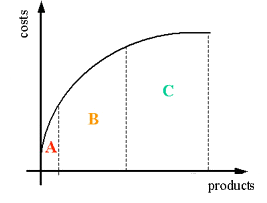
ABC Analysis – How to optimize warehouses and inventory

What is quality? Lean Thinking

Checklists: What is a checklist and how to use it?
Privacy overview.
Plan, Do, Check, Act (PDCA)
PDCA is an improvement cycle based on the scientific method of proposing a change in a process, implementing the change, measuring the results, and taking appropriate action. It also is known as the Deming Cycle or Deming Wheel after W. Edwards Deming, who introduced the concept in Japan in the 1950s. It is also known as PDSA, where the “S” stands for “study”.
The PDCA cycle has four stages:
- Plan — determine goals for a process and needed changes to achieve them.
- Do — implement the changes.
- Check — evaluate the results in terms of performance
- Act — standardize and stabilize the change or begin the cycle again, depending on the results
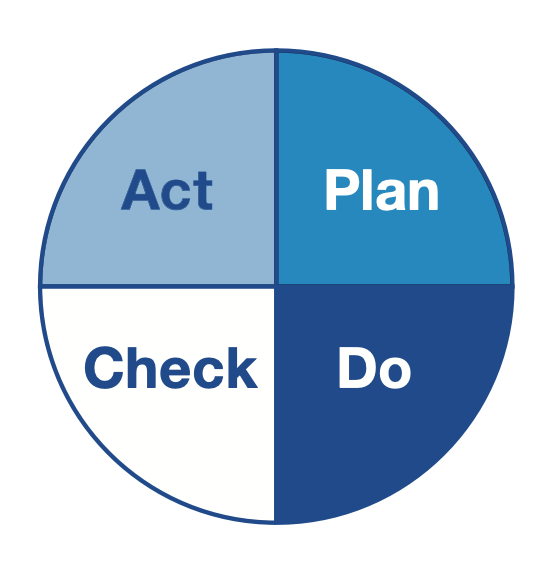
PDCA is the foundation of continuous improvement or kaizen. Leaders set targets (plan) against a stable baseline of performance. Teams implement improvements (Do) to achieve the targets. Then they measure (Check) the change to evaluate performance against the target. If the team has achieved a measurable gain, it standardizes (Act) the new method by updating the standardized work. This ensures the improvement is stable.
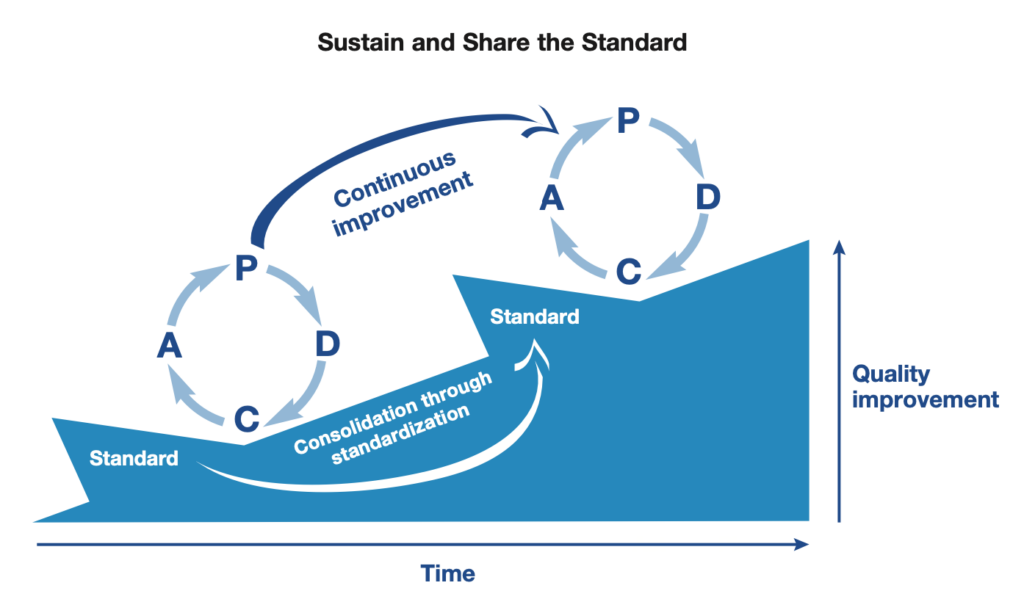
History of PDCA
Walter A. Shewhart was the first to develop a repeating cycle for improvement dubbed the Shewhart Cycle:
Edward Deming expanded the Shewart cycle into a four-step pattern for Japanese audiences. The Deming cycle related heavily to the concept of product quality, innovation, and learning-by-doing over the entire life cycle of a product.
Specifically, the Deming cycle runs:
1. Design the product with appropriate testing. 2. Make the product and test it in production and in the lab. 3. Sell the product to the market. 4. Test the customer experience and redesign for improvement.
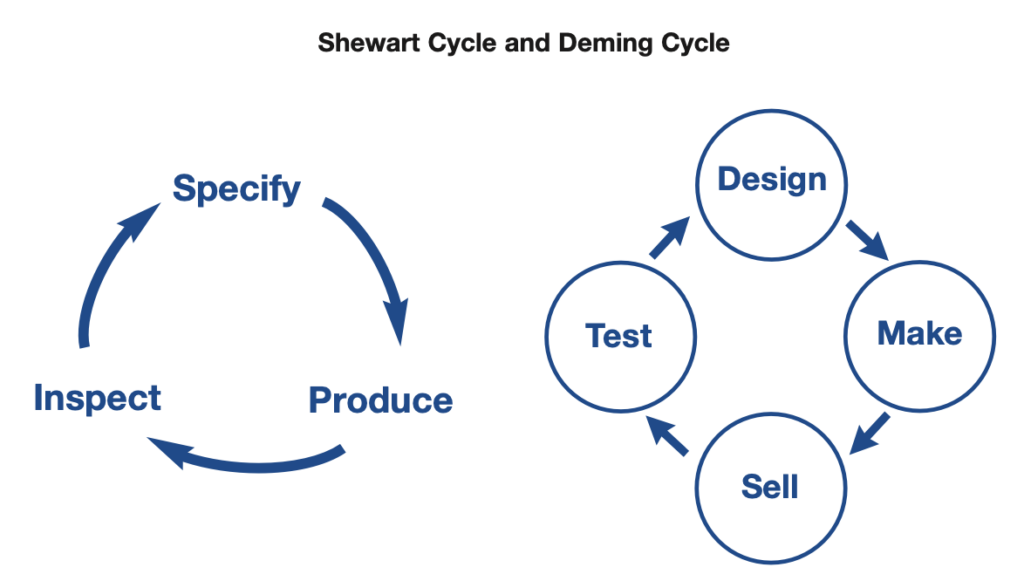
In 1951, the Japanese Union of Scientists and Engineers (JUSE) altered Deming’s framework into the more recognizable PDCA cycle. Although well over half a century has passed since the introduction of the Deming cycle to executives in Japan, most open-ended approaches still seek to repeat learning cycles as rapidly as possible, for obtaining customer feedback and making improvements in all pertinent areas.
The language may change slightly, but the basic thinking has not changed much. Consider the three-phase concept— Build , Measure , Learn —popularized by Eric Ries in his book, The Lean Startup . His iterative process is fundamentally similar to both the original Shewhart and Deming cycles. Words may change or be slightly altered, but the timeless, classic concepts stay the same.
Additional Resources
- Test Your PDCA Thinking By Reading Your A3 Backwards
- Create a Real A3, Do More Than Fill In Boxes
- Hazards at the Huddle Board: How to Coach a Team Away from “Fast Thinking” to Disciplined PDCA
- Practical Guidance for Using Humble Inquiry in PDCA Problem Solving and Coaching
- The Key to Lean — Plan, Do, Check, Act!
- Four Types of Problems — Art Smalley
Privacy Overview

In-Field Training
Problem solving, in field training, the tools of a lean production system are designed to identify problems. do you have the expertise at all levels of your organization to solve them ..
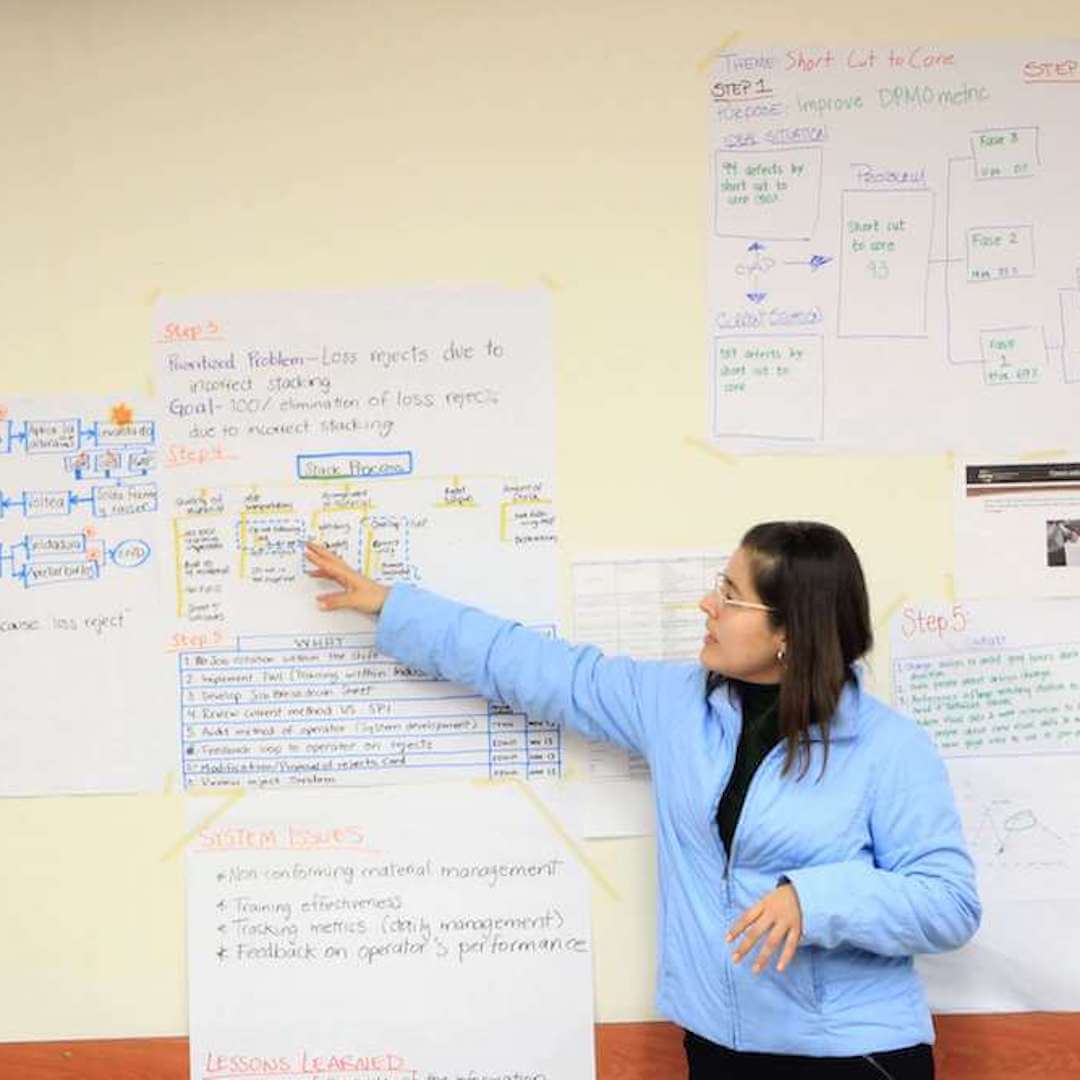
Practical PDCA Approach
Practice the 8 steps of Problem Solving and the concepts used at each step.

Share & Learn
Work & discuss in teams with participants from different industries

Shop Floor Activities
Practice the methodology working in real processes and problems.
- TRAINING DETAILS
Who should attend?
Leaders and managers that are interested in learning a structured way of addressing problems and developing teams capable to properly identify, analyse, solve and prevent issues., key benefits, learn how to set systems to recognize and prioritize problem s, develop a formal, standard approach for problem solving, learn how to keep track on the speed and effectiveness of the actions., how to use lessons learned to prevent future and systematic issues in other areas., in field problem solving training: we will learn and practice on the shop floor.
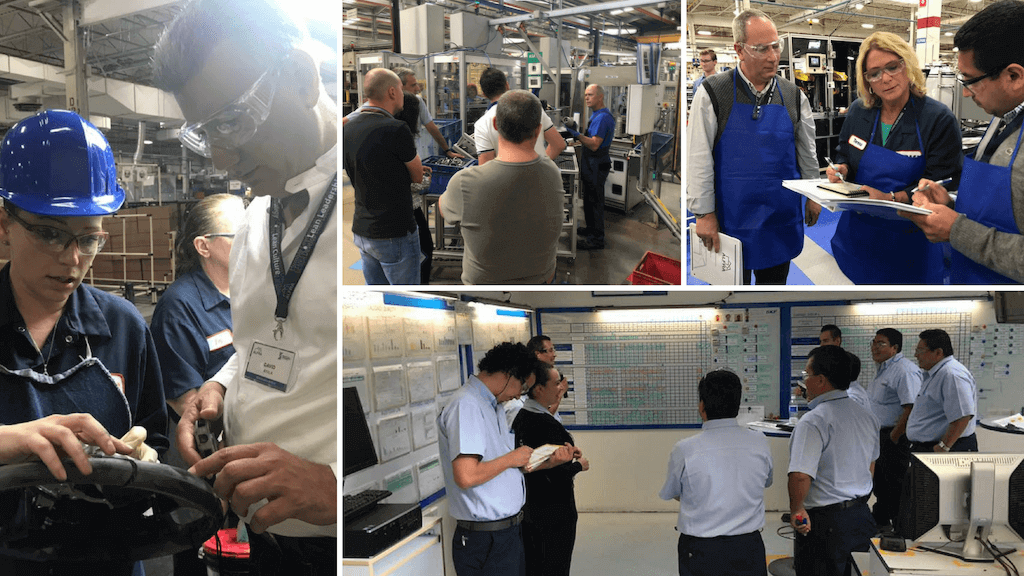
Practice the Problem Solving method (PDCA) and learn how to manage activities in order to identify, analyse, solve and prevent problems.
Problem solving: based on toyota’s 8 steps.
Can you clearly answer to these questions?
- How fast can you identify problems in your organization?
- Do you have a formal approach to solve problems ?
- How do you validate the effectiveness of the implemented actions?
- Are you learning from those problems to prevent future issues in other areas?
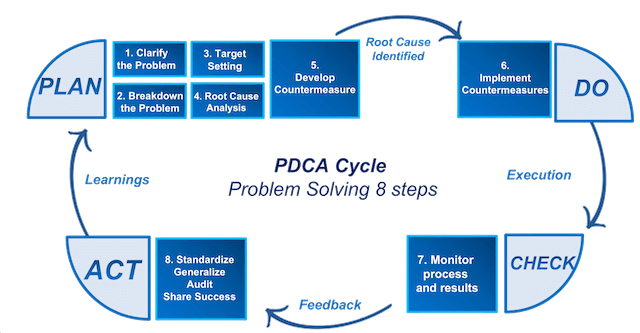
Host Company: BOA RBT – Arad, Romania
The boa group is one of the world’s leading manufacturers for flexible mechanical elements for the automotive and aerospace industry as well as for a wide range of industrial applications..
The headquarters is based in Stutensee, Germany. Today, the BOA Group consists of 15 subsidiaries and shareholdings in 13 countries.
The B OA Group develops, produces and distributes flexible stainless steel components for engine management , exhaust systems, fuel systems and side components for passenger cars and heavy vehicles.
BOA Romania is located in Arad. The plant started its operations in July 2014 producing metal hoses and exhaust gas recirculation pipes for the automotive industry as well as V-clamps for industrial applications.

Watch now: Problem Solving Introduction
Do you want to know more about problem solving.

Which are the 8 Steps of Problem Solving?
Do you want to go further we can answer any question.
Romania: (+40) 721 290 667
Hungary: (+36) 20 233 6220
Spain: (+34) 1 623 18 11 70
Let us know your questions, our team will contact you briefly.

- Product overview
- All features
- Latest feature release
- App integrations
CAPABILITIES
- project icon Project management
- Project views
- Custom fields
- Status updates
- goal icon Goals and reporting
- Reporting dashboards
- workflow icon Workflows and automation
- portfolio icon Resource management
- Capacity planning
- Time tracking
- my-task icon Admin and security
- Admin console
- asana-intelligence icon Asana AI
- list icon Personal
- premium icon Starter
- briefcase icon Advanced
- Goal management
- Organizational planning
- Campaign management
- Creative production
- Content calendars
- Marketing strategic planning
- Resource planning
- Project intake
- Product launches
- Employee onboarding
- View all uses arrow-right icon
- Project plans
- Team goals & objectives
- Team continuity
- Meeting agenda
- View all templates arrow-right icon
- Work management resources Discover best practices, watch webinars, get insights
- Customer stories See how the world's best organizations drive work innovation with Asana
- Help Center Get lots of tips, tricks, and advice to get the most from Asana
- Asana Academy Sign up for interactive courses and webinars to learn Asana
- Developers Learn more about building apps on the Asana platform
- Community programs Connect with and learn from Asana customers around the world
- Events Find out about upcoming events near you
- Partners Learn more about our partner programs
- Asana for nonprofits Get more information on our nonprofit discount program, and apply.
Featured Reads

- Project management |
- What is the Plan-Do-Check-Act (PDCA) cy ...
What is the Plan-Do-Check-Act (PDCA) cycle?

The PDCA cycle is a useful technique for addressing, analyzing, and solving business problems. Because the PDCA cycle is built on the process of continuous improvement, it offers a level of flexibility and iterative improvement.
PDCA cycle history
The PDCA cycle was first introduced by Walter Shewhart , the father of statistical quality control. In his book, Economic control of quality manufactured product , Shewhart applied the scientific method to economic quality control.
Shewhart’s thesis was further developed by W. Edwards Deming , who championed Shewhart’s work. Deming expanded on Shewhart’s idea and used the scientific method not only for quality control but also process improvement.
Deming went on to teach the method—which he called the Shewhart cycle—to Japanese engineers. There, the Shewhart cycle mixed with kaizen (the Japanese principle of continuous improvement , which was developed by Kaoru Ishikawa ), the Toyota production system, and lean manufacturing to become what we now call the Plan-Do-Check-Act (PDCA) cycle.
Nowadays, the Plan-Do-Check-Act cycle is commonly used as part of lean project management .
This methodology has many names, including:
Plan-Do-Check-Act cycle, or PDCA cycle
Deming cycle or Deming wheel
Shewhart cycle
Control cycle
Plan-Do-Study-Act cycle or PDSA cycle
When should you use the PDCA cycle?
The PDCA cycle is a framework for how to approach and resolve project management and process improvement problems. As a result, it can be implemented for a wide variety of projects. Teams that use the PDCA cycle effectively embrace the element of continuous improvement—rather than using the cycle for an end-to-end process, the PDCA cycle is a way to ensure continuous improvement and implement the iterative process .
The Plan-Do-Check-Act cycle is particularly useful when you want to:
Streamline and improve a repetitive work process
Develop a new business process
Get started with continuous improvement
Rapidly iterate on change and see immediate results
Minimize errors and maximize outcomes
Test multiple solutions quickly
4 steps to use the PDCA cycle
The four steps of the PDCA process are in the name: planning, doing, checking, and actioning. Notably, this process is a cycle, so as soon as you reach the end, you can start over from the beginning again.
The first step to any process improvement or project planning is to figure out what you need to do. Like any project plan , this includes a variety of information, including:
The project objectives
Success metrics
The project deliverables or end result
Project stakeholders
The project timeline
Any relevant project risks or constraints
You can use the PDCA cycle for a wide variety of projects. Whether you’re building a new project from scratch or using the PDCA as a quality improvement project, investing in a robust planning phase is a great way to set the project on the right track.
Keep in mind that PDCA is a cycle. It’s okay if you don’t have all of the answers the first time around, since you’ll probably run this cycle multiple times. Each time you re-run the PDCA cycle, evaluate your project plan to ensure it’s up-to-date and accurate towards your project goals.
Once you’ve ironed out your project plan, the next step is to try it out. Like most types of lean project management, PDCA embraces small, incremental changes. During the Do phase of the PDCA cycle, implement the project plan on a small scale to ensure it works.
Review the test you ran during the Do phase of the PDCA cycle to ensure everything went according to plan. More likely than not, you will identify things to improve on during the Do phase. After all, it isn’t called continuous improvement for nothing! The Check phase is critical to finding these small things before they get too big and problematic.
If necessary, revisit your project plan to ensure your project is still hitting your project objectives. Alternatively, if you realized you need to make a change to the project plan, you can also do so now.
After the check, move to the Act phase, which includes rolling out the full project or process improvement. Don’t forget that the PDCA cycle is a cycle. If you need to, return to the Plan phase to continuously improve your project or processes.
Pros and cons of the Plan-Do-Check-Act cycle
The PDCA cycle is a powerful tool to continuously improve, but there are also some disadvantages to using this system as well. Take a look at the pros and cons of the PDCA cycle:
Helpful for teams looking to get started with continuous improvement
Flexible methodology for virtually any project
Quickly implement change and see results
Use the PDCA as your standard operating procedure to increase org-wide standardization without the use of a project management office (PMO)
Proven continuous improvement methodology
You need support from senior management in order for the PDCA cycle to be particularly effective
Value comes from running the cycle over and over again. Not an effective methodology if you only plan on doing it once.
Requires time to implement and learn
Isn’t a great solution for urgent projects, since you typically expect to run the cycle multiple times
Planned-Done-Checked-Actioned
The PDCA cycle is an effective way to implement continuous improvement and problem solving. To get the most out of the PDCA cycle, set your projects up for success with project planning tools . Plan, manage, and track your team’s projects to hit your deliverables on time.
Related resources

New site openings: How to reduce costs and delays

8 steps to write an effective project status report

Provider onboarding software: Simplify your hiring process

Inventory management software: How to control your stock

What is the (PDCA) Plan, Do, Check, Act Cycle?
Author: Daniel Croft
Daniel Croft is an experienced continuous improvement manager with a Lean Six Sigma Black Belt and a Bachelor's degree in Business Management. With more than ten years of experience applying his skills across various industries, Daniel specializes in optimizing processes and improving efficiency. His approach combines practical experience with a deep understanding of business fundamentals to drive meaningful change.
PDCA (Plan, Do, Check, Act) is a time-tested methodology that forms the backbone of continuous improvement in various industries. The PDCA cycle, which embraces simplicity and systematic progression, facilitates problem-solving and process improvement by following four distinct stages. These stages create a circular flow that promotes continuous refinement and adaptation.
The PDCA cycle provides a structured approach that can be tailored to various scenarios, whether you’re looking to address specific organizational challenges, standardize processes, or foster innovation. This article delves into the essence of PDCA, examining its four phases, applications, and why it is such an effective tool for continuous growth and improvement. Join us as we unpack the PDCA cycle’s dynamics, providing insights and practical advice on how to effectively apply this time-tested methodology in your organization or project.
What is PDCA?
PDCA (Plan, Do, Check, Act) is a four-step methodology for continuous improvement and problem solving in a variety of organizational processes. It starts with planning (Plan) a change or solution, then doing (Do) it on a small scale. The results are then evaluated (Check) to determine the effectiveness of the plan, leading to the final action (Act) of either broadly implementing the change or revising the plan. The cyclical nature of PDCA encourages continuous refinement and adaptation, making it a versatile tool for improving quality, efficiency, and innovation in a wide range of industries and settings.
Why use PDCA?
The PDCA (Plan, Do, Check, Act) cycle is an indispensable tool in the world of process improvement and project management, and here’s why it’s so widely embraced:
1. Simplicity and Structure:
PDCA offers a simple and structured approach that anyone can follow. Its four-stage cycle – Plan, Do, Check, Act – provides clear guidelines that can be applied to various problems and processes. This simplicity makes it accessible to team members at all levels, fostering inclusivity and alignment.
2. Adaptability:
The cycle is not confined to a specific industry or project type. It’s a flexible framework that can be adapted to different contexts, whether it’s manufacturing, logistics, or healthcare. This adaptability makes it a universal tool for continuous improvement.
3. Continuous Improvement:
Unlike linear models, PDCA operates in a continuous loop. After the Act stage, the cycle repeats, allowing for ongoing refinement and optimization. This iterative nature ensures that improvements are sustained and built upon, leading to long-term growth and excellence.
4. Risk Mitigation:
By encouraging small-scale testing and careful analysis (Do and Check stages), PDCA helps in identifying and mitigating risks early in the process. This controlled approach minimizes the chances of large-scale failures and promotes a culture of thoughtful experimentation.
5. Enhanced Communication and Collaboration:
The clear structure of the PDCA cycle facilitates communication and collaboration within teams. Everyone knows the stage of the process and their role in it, leading to greater synergy and efficiency.
6. Problem-Solving and Innovation:
PDCA’s systematic approach encourages problem-solving and innovation. By continuously evaluating and adapting the plan, organizations can discover new solutions and approaches that may not have been apparent at the outset.
What are the four phases of the PDCA cycle?
The PDCA cycle has four key stages as can be seen in the graphic below.
Stage 1 – Plan – identify and define the problem, creating a plan for the change.
Stage 2 – Do – Test the potential solutions from the plan.
Stage 3 – Check – Study the results, analyze the results and understand what you have learnt.
Stage 4 – Act – Take action based on the outcome of the previous step. If the change worked implement what was learnt from the test into the full process. If the change does not produce the required results repeat the cycle with a different plan.
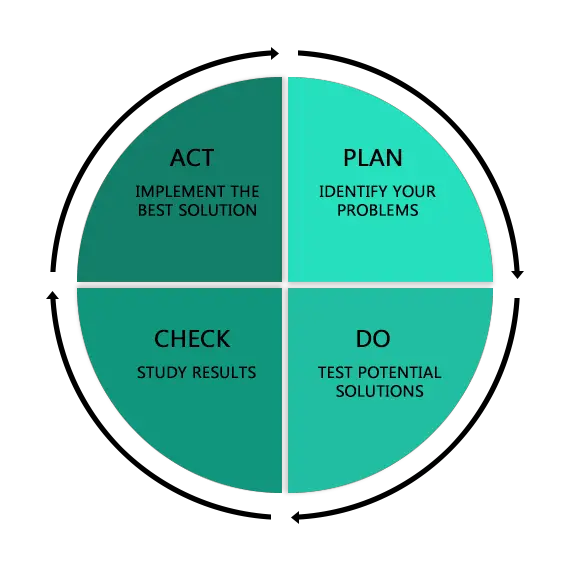
Within the planning stage, it is important to have a clear understanding of what the problem is you are trying to solve. Ensure those involved all have a clear and consistent understanding.
Once a consistent understanding has been established, you need to create a plan.

Within your plan is important to consider:
- What are the goals?
- How are we going to do it?
- What resources do we need?
- Who is responsible for taking action?
- When are the actions going to be done?
Start implementing the plan as set out in the previous stage. Ensure everyone knows their role and responsibility, consider creating an effective communication plan for all stakeholders as changes to the process are likely and you need to ensure those involved understand what is happening and why.
You might find that the plan needs to adjust during this step as you implement your plan, therefore it is advised to start small and then expand once you are confident in the plan.
Review the results of the trial from the previous stage, did this produce the expected results?
Ensure you review the results with the team involved as they will be able to provide insight and understanding of the results based on their involvement.
Ensure you have collected sufficient data so that the test is statistically significant and not just a one-time result with may not be repeated.
Once everything has been tested and reviewed if the results meet the expected outcome it is time to implement the solution full-time into the process. Ensure all stakeholders are fully aware of what the change is and what they need to do to sustain the change. Tools such as Standard Operating Procedures (SOPs) or other training aid are useful in this step. During this stage it is useful to continue to check the process for a period of time after to ensure all issues have been resolved and that the problem does not reappear elsewhere.
Once this improvement is closed out you can repeat the cycle with further improvements to continually make improvements to the process.
If the results from the test do not meet the expected outcome return to the plan stage and repeat the process with a different potential solution.
When to use the PDCA cycle?
When an organization is looking to improve its processes or when a specific problem needs to be addressed, the PDCA cycle is frequently used. In this answer, we will go over when and how to use the PDCA cycle for project improvement.
- When there is an issue or problem: The PDCA cycle is frequently used to solve problems or issues that an organisation may be experiencing. When a problem arises, the PDCA cycle can be used to identify the root cause of the problem, develop a solution, implement the solution, and then evaluate the results to determine if the problem has been solved. This can assist organisations in addressing issues quickly and effectively while minimising their impact on the business.
- When continuous improvement is required: When an organisation wants to continuously improve its processes or products, the PDCA cycle is used. Organizations can use the PDCA cycle to identify areas for improvement, develop and implement a plan to address those areas, and then evaluate the results to see if the changes have resulted in an improvement. This can assist organisations in remaining competitive and meeting their customers’ changing needs.
- When standardisation is required : The PDCA cycle can also be used to standardise processes within an organisation. Organizations can use the PDCA cycle to identify best practices, develop standard processes, implement those processes, and then evaluate the results to ensure that the processes are functioning as intended. This can assist organisations in increasing efficiency, reducing waste, and ensuring consistent quality.
- When innovation is required: The PDCA cycle can also be used to drive innovation within an organisation. Organizations can use the PDCA cycle to generate new ideas, test those ideas, evaluate the results, and then implement the best ideas. This can assist organisations in staying ahead of the competition and discovering new ways to meet their customers’ needs.
The PDCA methodology is usually best suited to situations where the improvement needs a small amount of resouces and is a less intense problem. Whereas if these are greater you may consider A3 , 8D , DMAIC or DFSS for your project.
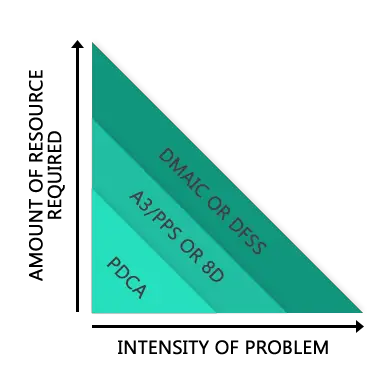
In conclusion, the PDCA cycle is a useful methodology for improving processes, products, and services within an organisation. It can be used in a variety of situations, including when there is a problem or issue, when continuous improvement is required, when standardisation is required, and when innovation is required. Organizations can use the PDCA cycle to quickly identify areas for improvement, develop and implement plans to address those areas, and then evaluate the results to ensure that the desired outcomes are met.
To summarise, the PDCA cycle is a valuable methodology for organisational continuous improvement. It is a straightforward approach that can be applied to small or simple change projects and is also known as the Deming cycle or Shewhart cycle. The PDCA cycle’s four stages: Plan, Do, Check, and Act, provide a logical sequence of steps for problem-solving. It enables controlled trials of potential solutions with adequate analysis prior to full implementation.
PDCA is useful for keeping the project team on track, facilitating communication, and keeping stakeholders focused. It is ideal for simple improvement projects that do not require extensive analysis. It is a powerful tool for organisations seeking to improve their efficiency and achieve continuous improvement.
- Moen, R. and Norman, C., 2006. Evolution of the PDCA cycle .
Was this helpful?

Daniel Croft
Hi im Daniel continuous improvement manager with a Black Belt in Lean Six Sigma and over 10 years of real-world experience across a range sectors, I have a passion for optimizing processes and creating a culture of efficiency. I wanted to create Learn Lean Siigma to be a platform dedicated to Lean Six Sigma and process improvement insights and provide all the guides, tools, techniques and templates I looked for in one place as someone new to the world of Lean Six Sigma and Continuous improvement.
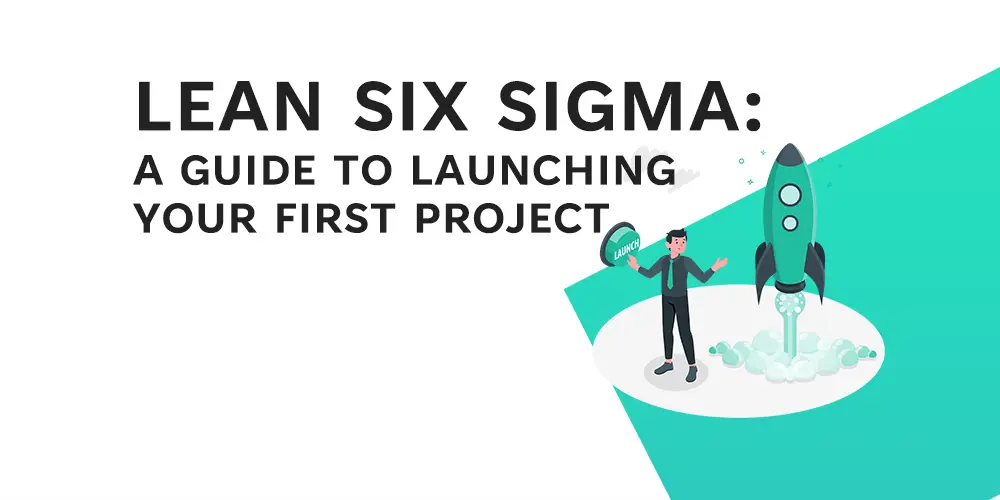
Getting Started with Lean Six Sigma: A Guide to Launching Your First Project
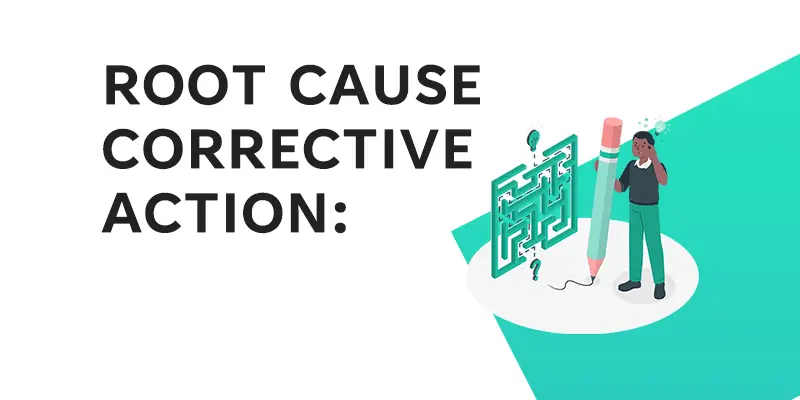
The Importance of Root Cause Corrective Action (RCCA)
Free lean six sigma templates.
Improve your Lean Six Sigma projects with our free templates. They're designed to make implementation and management easier, helping you achieve better results.


Understanding Process Performance: Pp and Ppk
Understand Process Performance (Pp) and Process Performance Index (Ppk) to assess and improve manufacturing processes.…
LIFO or FIFO for Stock Management?
Choosing between LIFO and FIFO for stock management depends on factors like product nature, market…
Are There Any Official Standards for Six Sigma?
Are there any official standards for Six Sigma? While Six Sigma is a well-defined methodology…
5S Floor Marking Best Practices
In lean manufacturing, the 5S System is a foundational tool, involving the steps: Sort, Set…
How to Measure the ROI of Continuous Improvement Initiatives
When it comes to business, knowing the value you’re getting for your money is crucial,…
8D Problem-Solving: Common Mistakes to Avoid
In today’s competitive business landscape, effective problem-solving is the cornerstone of organizational success. The 8D…

PDCA (Plan-Do-Check-Act)
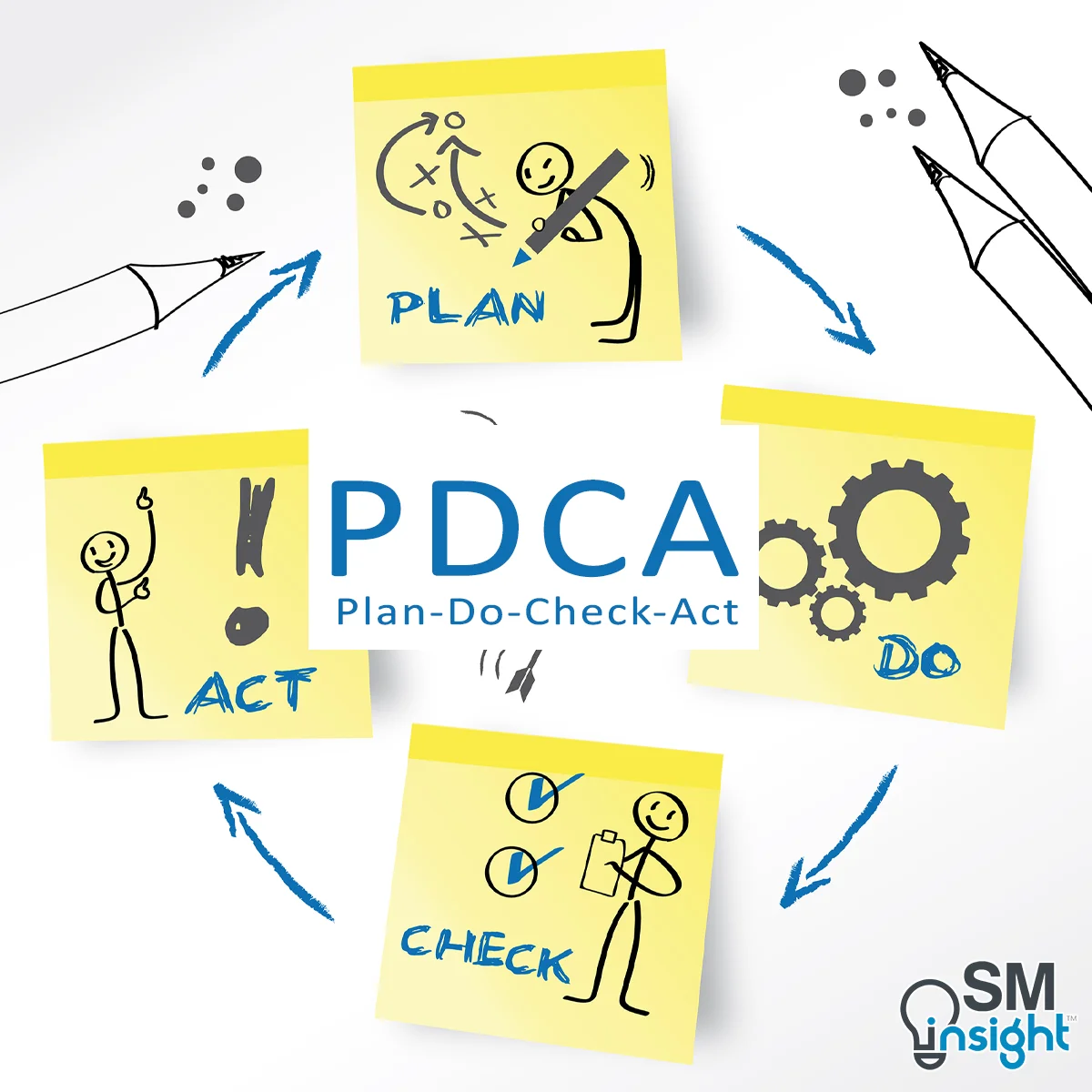
What is the PDCA (Plan-Do-Check-Act) Cycle
Plan-Do-Check-Act Cycle (PDCA) is a four-step, iterative by-design method used for control and continual improvement of processes and products. It is also known as the Plan-Do-Study-Act (PDSA) cycle, Deming cycle, Control Circle/Cycle or the Shewhart cycle.

PDCA is an evidence-based participatory approach to problem-solving and is found to be an effective tool for quality improvement.
Origin of PDCA
The beginnings of PDCA emerged from the principles of the ‘Scientific Method’, which originated with Galileo but has its roots in the teachings of Aristotle. It is a method for developing ideas based on observation, then testing them through experiments and finally refining, changing, or eliminating the ideas. [2]
Dr. Walter Shewhart first adapted the scientific method for industry and presented it as a linear flow of ‘specification’, ‘production’ and ‘inspection’. In 1939, he changed the linear sequence to a cycle to show how refinement and change lead to an iterative approach to product development.
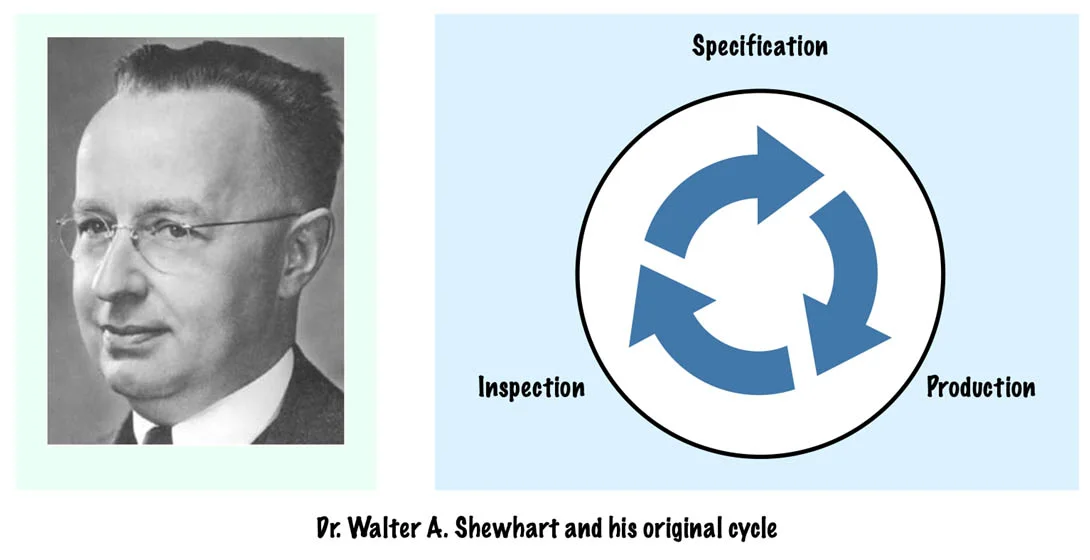
The Shewhart cycle was further developed by W. Edwards Deming in what became known as the ‘Deming Wheel’.
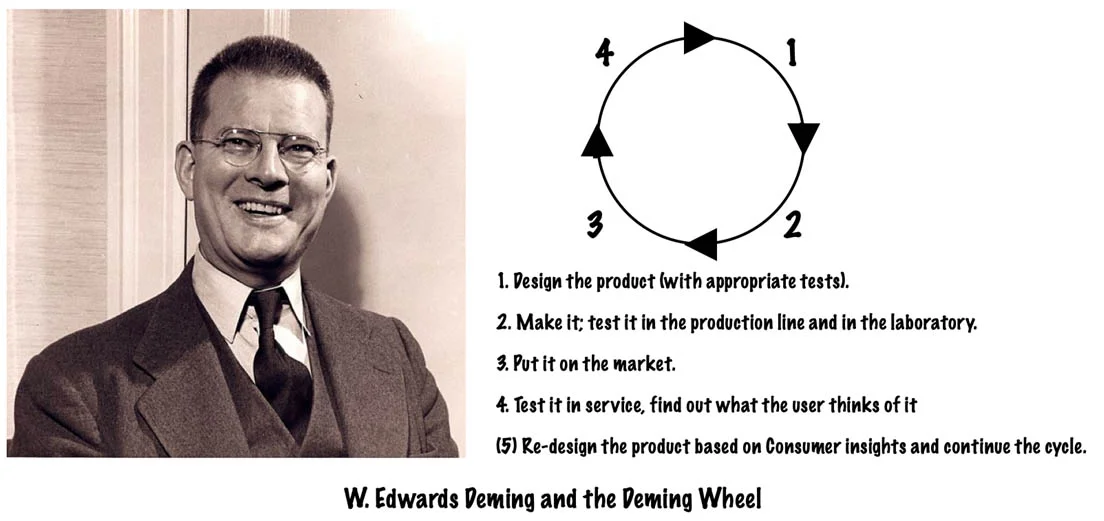
In 1950, Deming presented his ideas to the Japanese Union of Scientists and Engineers (JUSE) which then was popularized as the Plan, Do, Check, Act cycle or PDCA. [2]
Why use PDCA
Organizations often plan and then intend to execute, but the reality is neither linear nor predictable for this approach to be effective in reaching the target conditions.
Regardless of how well a plan is made, they must navigate a zone of uncertainty commonly referred to as the “Grey Zone.” Unforeseen problems, abnormalities, false assumptions, and obstacles will appear along the path to any target.

A good analogy is a person climbing stairs in the dark with a flashlight. Because the target condition lies beyond the reach of the flashlight, the path to attaining it cannot be predicted with exactness. Thus, the person must find that path by experimenting.
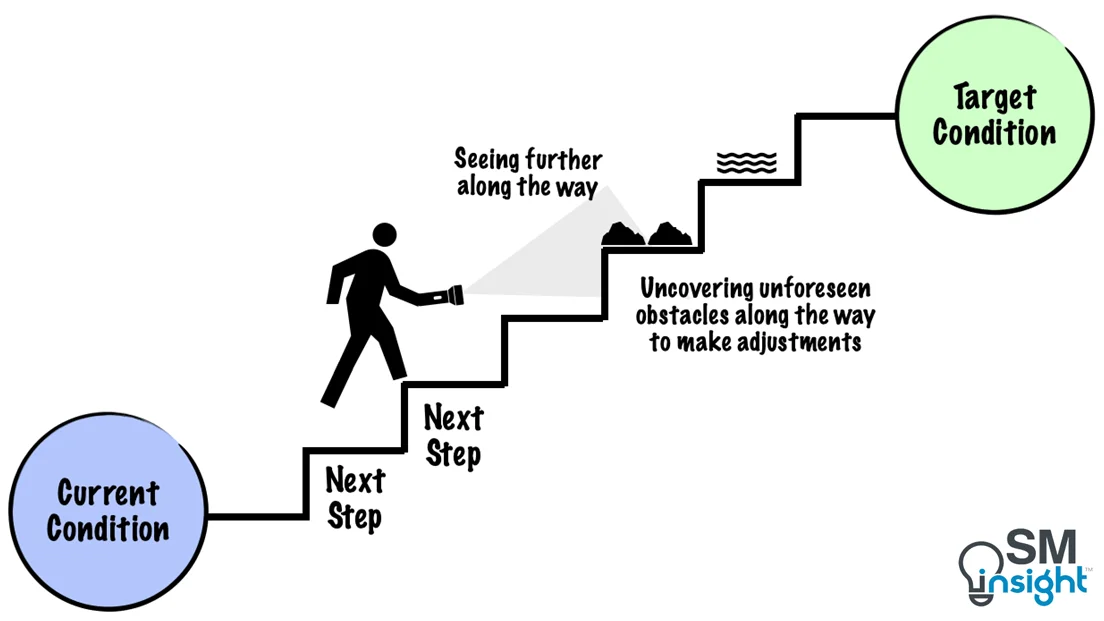
This is the central approach of PDCA. To expect uncertainty and pay attention to adjust along the way based on learnings. PDCA provides a practical means of attaining a challenging target condition by formulating hypotheses and testing them with information obtained from direct observation.
The Plan-Do-Check-Act (PDCA) cycle
The procedure or steps of experimentation in the PDCA cycle are summarized as below:
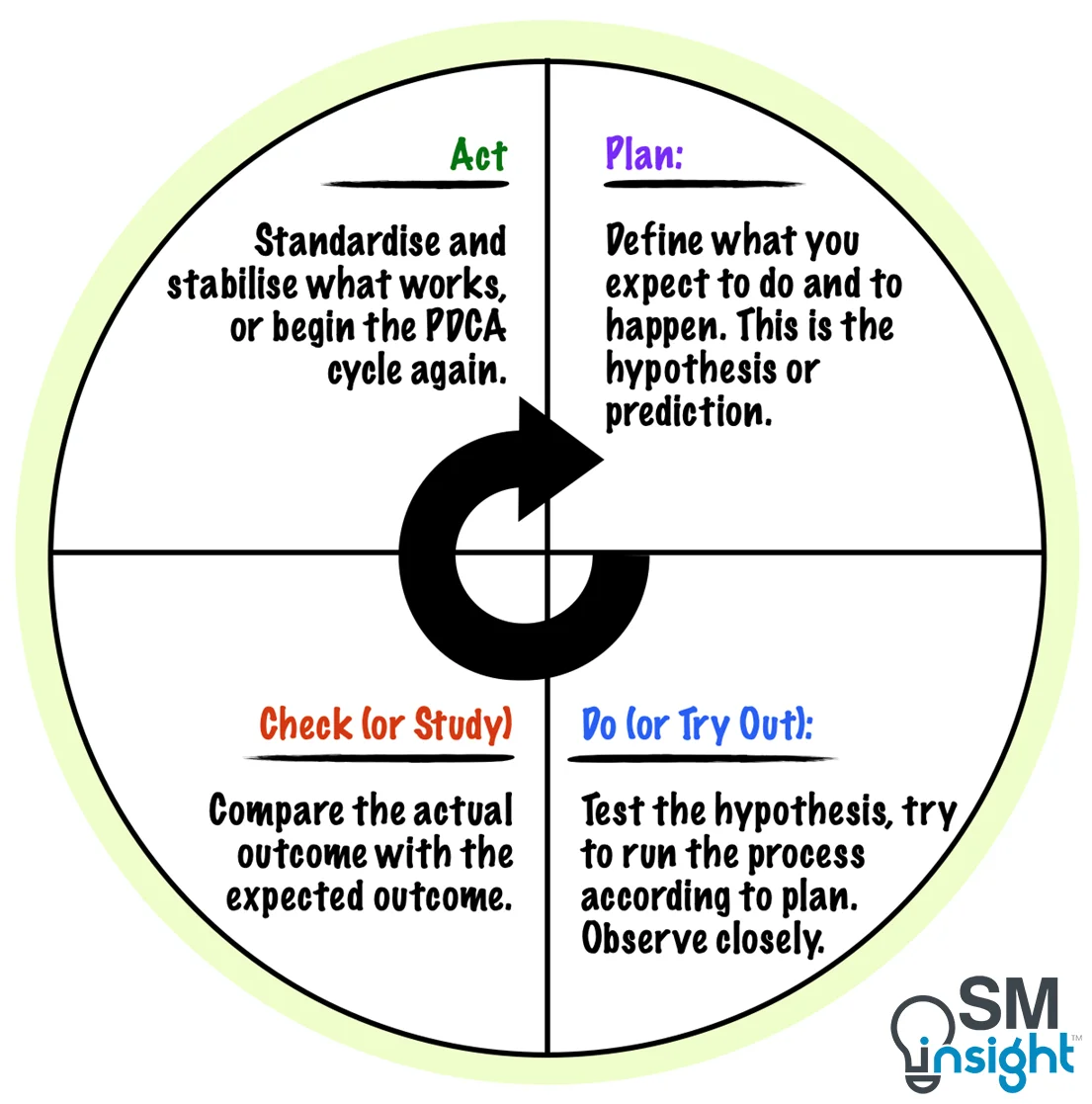
The four stages of PDCA
PDCA’s four stages constitute a scientific process of acquiring knowledge and are explained in more detail as follows:
P is for Plan
In the Planning stage, problems are identified and analyzed according to the following order:
- Select and prioritize the problems to be analyzed
- Clearly define the problem and establish a precise problem statement
- Perform situation analysis (to be used as baseline data)
- Set a measurable goal
- Perform root cause analysis (identify potential causes of problems)
- Identify intervention(s) that will address the root causes of problems
- Select an intervention and develop an action plan
D is for Do
At this stage, the team implements an action plan developed in the previous stage to make the desired changes. This involves the following steps:
- Execute the action plan on a trial or pilot basis
- Practice the proposed method(s)
- Make the changes
- Don’t strive for perfection but look for what can be done in a practical way
C is for Check
At this stage , data is collected once again to measure if the actions taken have improved the situation. It involves the following steps:
- Check whether the standard is being followed
- Measure the indicator and compare it with the baseline. Record the results
- Check what is working and what is not
- Identify systematic changes
- Practice and improve the activities as per the defined method
A is for Act
In the Act phase, interventions that are found to be effective are standardized by developing Standard Operating Procedures (SOPs), which involve the following steps:
- Continue activities that went as planned and were found effective
- Review (why) activities that did not perform well and propose changes
- Adopt the intervention(s)/ solution(s) as standard (standardize)
- Plan ongoing monitoring of the intervention(s)/ solution(s)
- Continue to look for incremental improvements and refine intervention(s)/ solution(s)
- Look for the next improvement opportunity
At the end of the fourth stage, the PDCA cycle restarts with the aim to solve another problem (or further improve the same problem) to achieve a continuous and uninterrupted improvement.
Seven steps in the PDCA cycle
PDCA cycle consists of seven steps spread over four stages, as shown:
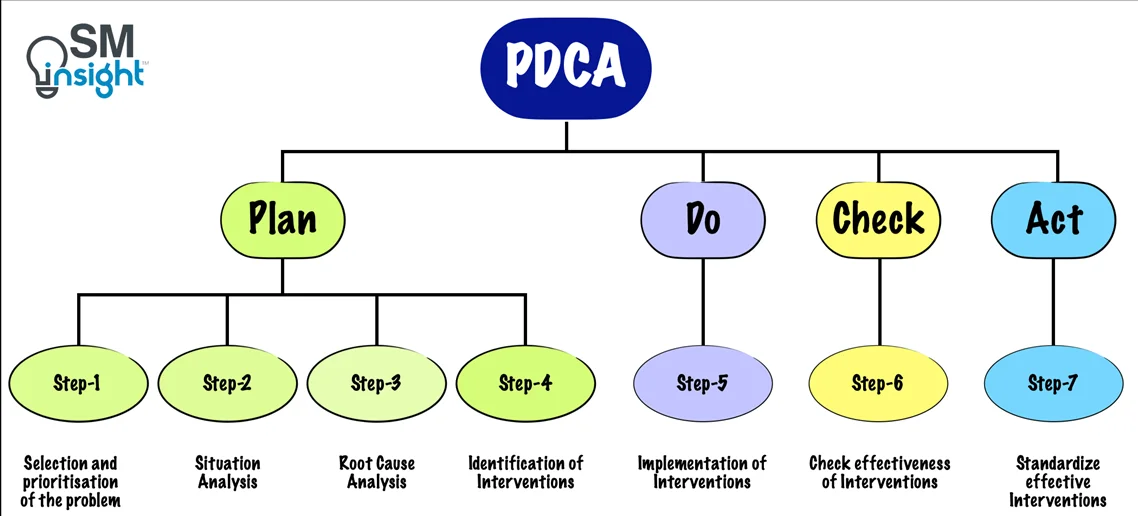
Step 1: Selection and problem prioritization
A problem is a brief description/statement of the weakness in the process or an issue to be solved. The tool most often used in this step is a Flowchart [6] . Alternatively, if a single problem is to be selected from a set of problems, a Selection Matrix [7] or a Fish Bone Diagram [8] may be used.
Selecting a problem is an iterative process where subsequent steps could lead to further refinement of the definition. A good problem should:
- Be customer‑focused.
- Complement the company’s and division’s goals.
- Address a weakness
- Be measurable
- Have a high probability of success within a reasonable time frame (3‑4 months)
- Be well-framed in one complete sentence
- Avoid the use of abstract words, acronyms, and location‑specific lingo
- Be action‑oriented
- Avoid the use of absolutes
- Address one of the 5 evils (defects, delays, mistakes, waste, accidents).
- Avoid stating the cause in the problem definition. (This is jumping to Step 3.)
- Avoid stating the solution in the problem definition. (This is jumping to Step 4.)
Problems can be prioritized based on:
- Their impact on the business
- Whether there are enough resources available to address them
- The ease of observing changes
- The extent to which team members have control
Step 2: Situation analysis
In this step, the focus is on gathering facts about the problem. The tool most often used at this point are Checksheets [9] and Pareto Charts [10] . Following are some of the key aspects of situation analysis:
- Before collecting data, all possible causes must be brainstormed.
- Ask 4W and 1H when collecting data: – Who is involved? – What problem/type of problem occurs? – When does it occur? – Which part of the process/type of product does it involve? – How much/many products/defects/etc. are involved?
- Limit data collection to what is needed. (Often, a sample will be sufficient.)
- Stratify (group) the data in many forms [11] .
- Zero down on a few probable causes using a Pareto chart.
Step 3: Root cause analysis
A root cause is the fundamental reason behind negative process outcomes. A fishbone diagram [8] is the primary tool for root cause analysis. The root cause must be controllable and is found using the following approach:
- Answer the question, “Why did this ‘problem’ occur?”
- Brainstorm around: – Contributing factors. – The root cause of the contributing factors.
- Follow a fact-based approach. Assuming to know the cause can be counterproductive.
- Interview people who know the process.
- Construct/refer to a Flowchart of the process.
- Construct a Cause/Effect Diagram.
- Recycle back to Step 2 if required.
Step 4: Identification of intervention
This step brings ideas together to address a problem’s root cause. It is important to be open to options and think creatively. Affected individuals must be involved, and preference must be given to improving existing processes before revamping them entirely. Experiments are run to test solutions.
The proposed intervention must:
- Prevent the reoccurrence of the root cause.
- Be practical to implement, efficient and affordable.
- Be free from conflict with other processes or activities.
- Address the 4W’s and 1H (discussed in Step-2).
- Have a timeline describing the implementation schedule.
- Have management support.
- Establish metrics that will confirm that the solution worked.
Step 5: Implementation of the intervention
Putting the implementation plan into action involves carrying out the ordered steps outlined below, implementing the change itself, and collecting the information that will indicate success.
- Review the objectives of the solution(s).
- Develop an action plan.
- Share the action plan with section staff.
- Identify the potential resistance.
- Determine the prerequisite(s) of the implementation.
- Develop a step-by-step guide to implement the action plan (Usually, the time for implementation is about 2 to 3 months, while the total time for one PDCA cycle is about 6 months).
- Assign responsibility for each activity.
- Determine what information is needed to monitor progress (using a checklist).
Teams must establish checkpoints periodically to verify if the implementation is going as planned and update everyone involved on the progress.
Step 6: Checking the effectiveness of implementation
Using tracking indicators, effectiveness can be checked through the following steps:
- Review data collection methods in Step 2
- Collect data using the same methodology
- Compare frequency before and after PDCA and calculate incremental reduction/ increase rate
- Make a Run Chart to observe the trend over time [12]
- Check achievement against the target set earlier in the aim statement.
The situation before and after PDCA can also be portrayed using a graph as shown below:
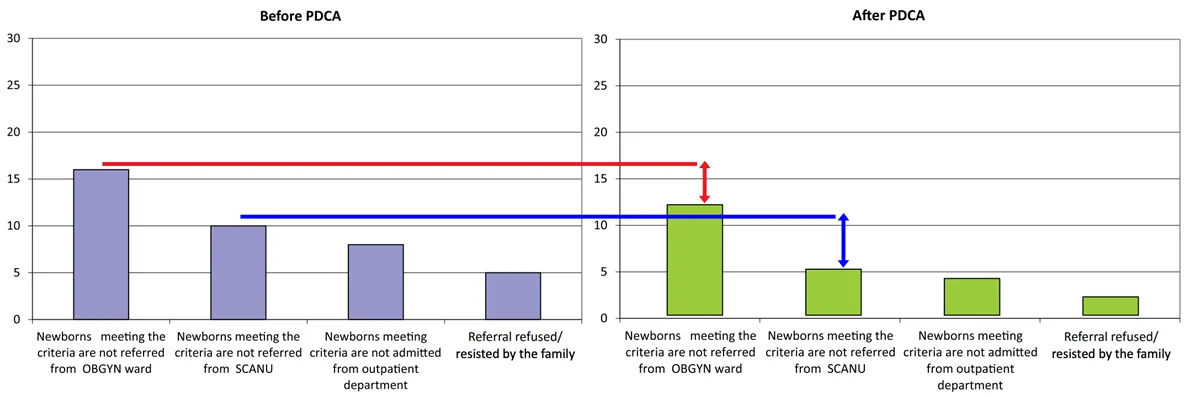
A Run Chart can be used to observe improvements over time. For example, the run chart (below) shows a decreasing trend in the number of patients who did not follow prescribed medication. This indicates the PDCA measures adopted by the hospital to address the issue have shown improvements over time.
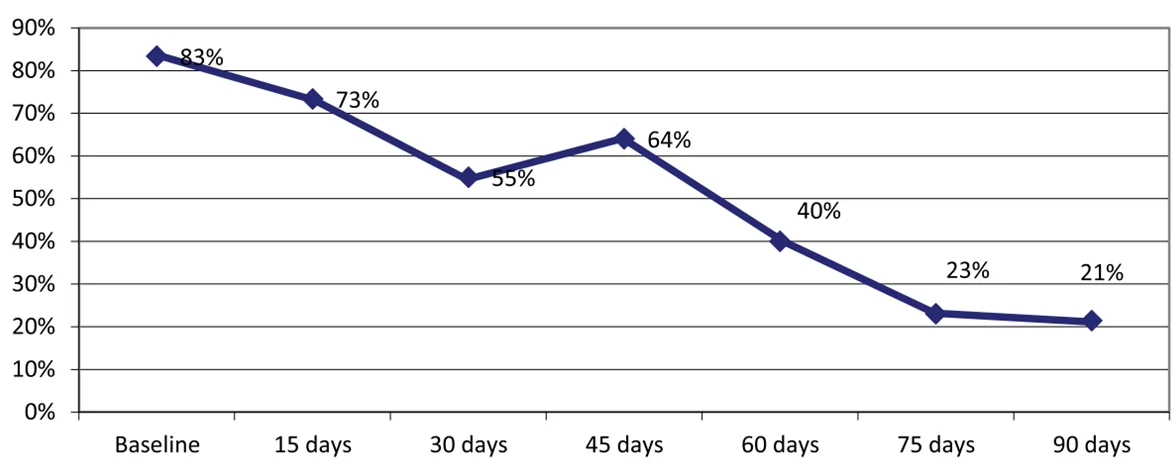
Step 7: Standardization of effective interventions
At this stage, the activities found to be effective in reducing or eliminating the problems are standardized using the following steps:
- List effective interventions identified in the previous step.
- Develop documentation (SOPs) to adopt successful intervention(s).
- Develop a checklist to assess the progress of implementing standardized activities.
- Share the plan and checklist with all concerned.
Standardization brings several benefits such as:
- Reduces variability.
- Ease in training new staff.
- Reduced chance of strain and injuries (ensures safety for internal/ external clients).
- Ease of following well-established practices reduces task time.
- Increases staff confidence & motivation.
Discipline is the key to successful standardization of an effective intervention.
PDCA at Toyota
No organization has ever come close to matching Toyota’s stellar performance in automobile manufacturing. It has cultivated a culture of excellence, efficiency, and customer satisfaction like no other.
PDCA at Toyota uses “Rapid Cycles,” where individual PDCA cycles are turned as quickly as possible, sometimes even taking only minutes each. The idea is to not wait for a perfect solution but to take the step at the earliest with available resources so that teams can spot the next challenge.
Toyota believes that a provisional step “now” is preferable to a perfect step “later”, and invests in prototypes and experiments up front, which may seem like an extra expense but has proven to reduce cost in the long run.
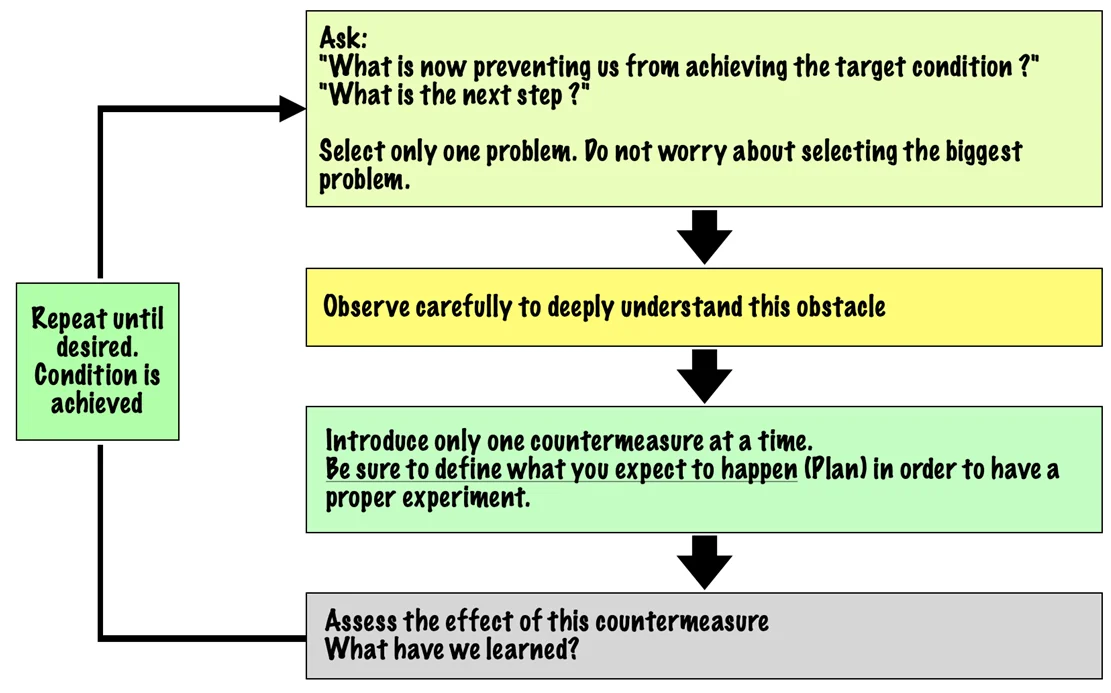
Toyota uses single-factor experiments, that is, to address one problem at a time and only change one thing at a time in a process. This helps see cause and effect and better understand the process.
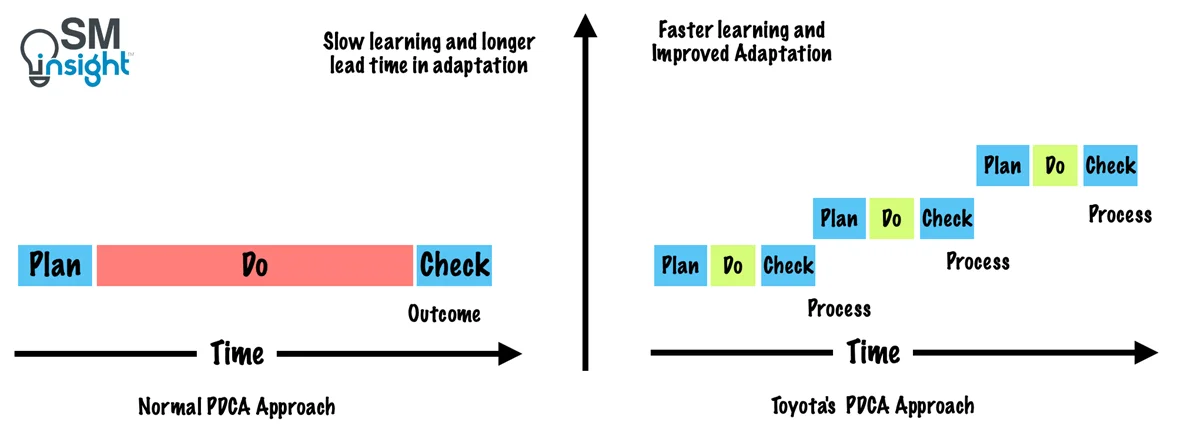
Toyota’s success is not due to sudden innovation or having air-tight plans but the ability to execute more effectively in the face of unforeseeable obstacles and difficulties. They spot problems at the process level much earlier when the problems are still small and address them quickly while uncovering information along the way.
Example of PDCA (the Toyota way)
Consider the process of getting up and going to work with a target condition of being in the car and ready to drive 60 minutes after waking up.
Here is one possible PDCA cycle for the process:
| Be in the car 60 minutes after waking up. (Target condition) | |
| Wake up and go through the morning routine, get into the car. | |
| Once in the car check how long it took. | |
| (Next step to be determined) |
Assume that with the above PDCA plan, a person sits in the car to find that the morning routine took 64 minutes, or four minutes over the target condition.
What has he learned about the process from this experiment?
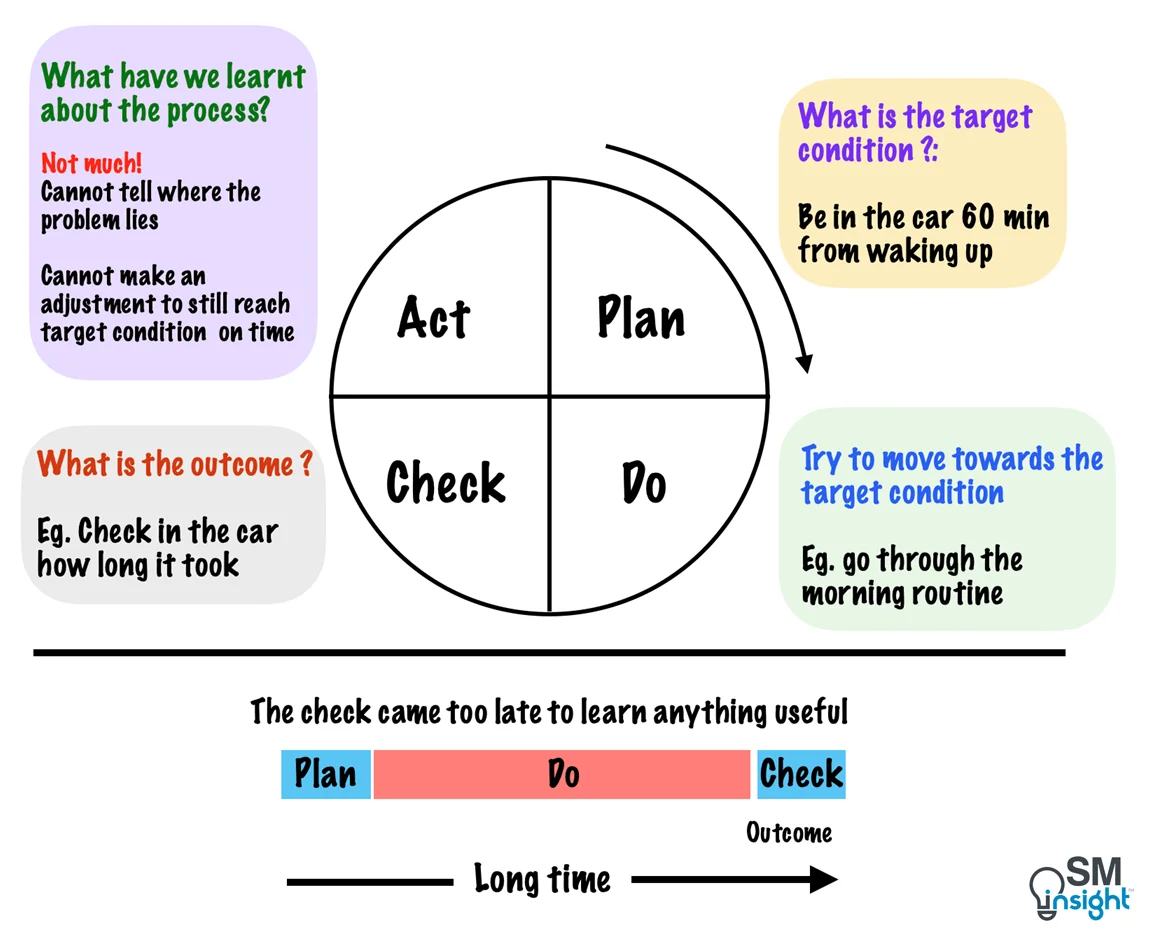
As depicted in the figure above, not much! The total time taken was over 60 minutes (too long), but it cannot be said where in the morning routine the problem lies. Also, it is too late to make an adjustment that would still achieve the target condition.
There are two things wrong with this PDCA experiment:
- The “check” comes too late to learn anything useful or to adjust on the way.
- The target condition specifies only an outcome. (it is not actually a target condition at all.)
Many seemingly large and sudden changes develop slowly. The problem is that organizations either fail to notice the little shifts taking place along the way or they do not take them seriously.
No problem is too small for a response. To be consciously adaptive, an organization must recognize abnormalities and changes as they arise and are still small and easy to grasp.
To be able to experiment in shorter cycles, a more detailed target condition is necessary. Such a target condition must generally include the following information:
- The steps of the process, their sequence, and their times
- Process characteristics
- Process metrics
- Outcome metrics
While a longer overall PDCA cycle must check the outcome, many short PDCA cycles must check process metrics along the way. Every step on the “staircase toward a target condition” is a PDCA cycle. Each step is a hypothesis, where what is learned from testing that hypothesis may influence the next step.
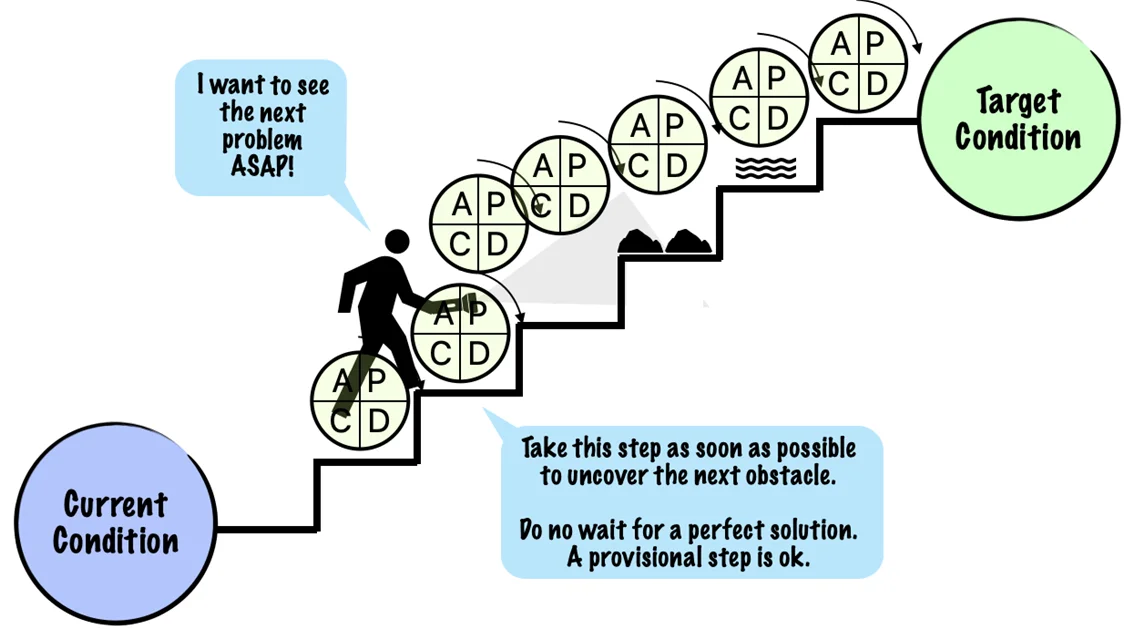
Accordingly, a modified and more effective experiment for the process of getting up and going to work, beginning with a better target condition, will look as follows:
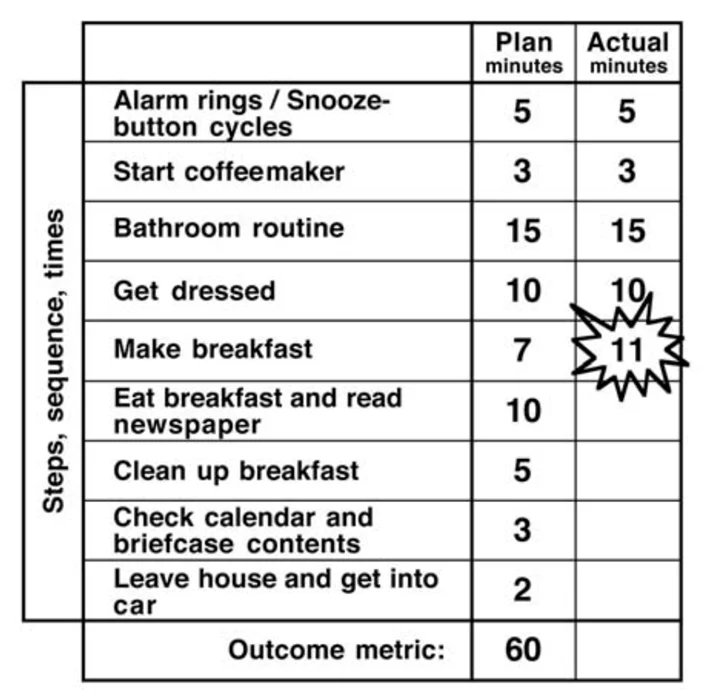
As seen from the figure, the step “Make breakfast” has taken four minutes longer than the planned time. From this, it is not only known where the problem is, but an adjustment can also be made to the remaining steps to still achieve the 60-minute outcome.
Questions critical to PDCA
PDCA phase of the improvement, after a target condition has been established, needs to answer the following five questions that are built on one another.
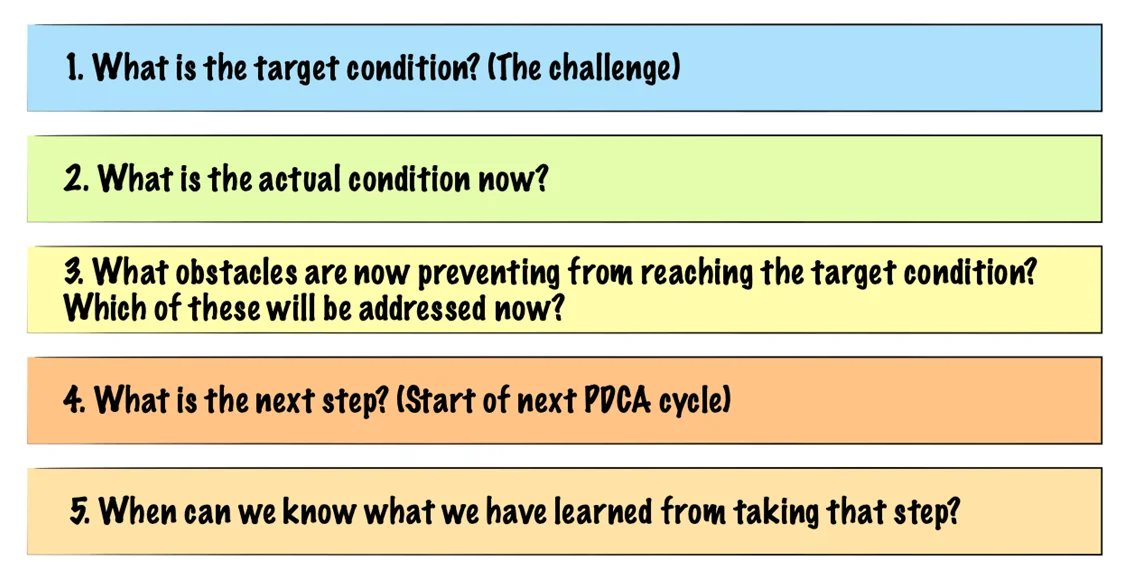
The sequence of these five questions acts as a device to give a routine and a mental pattern for approaching any process or situation. These questions distill part of the improvement down to a point where it becomes accessible and usable by anyone.
1. “The plan-do-check-act procedure”. Whale Design, https://www.shutterstock.com/image-vector/plandocheckact-procedure-deming-cycle-fourstep-model-2169522173 Accessed 22 Jul 2023
2. “Shewhart cycle”. Praxis Framework, https://www.praxisframework.org/en/library/shewhart-cycle Accessed 19 Jul 2023
3. “Walter A Shewhart”. Wikipedia, https://en.wikipedia.org/wiki/Walter_A._Shewhart Accessed 19 Jul 2023
4. “W. Edwards Deming Photo Gallery”. The Deming Institute, https://deming.org/w-edwards-deming-photo-gallery/ Accessed 19 Jul 2023
5. “Toyota Kata: Managing People for Improvement, Adaptiveness and Superior Results”. Mike Rother, https://www.amazon.com/Toyota-Kata-Managing-Improvement-Adaptiveness-ebook/dp/B002NPC0Q2https://www.amazon.com/Toyota-Kata-Managing-Improvement-Adaptiveness-ebook/dp/B002NPC0Q2 Accessed 19 Jul 2023
6. “WHAT IS A FLOWCHART?”. American Society for Quality, https://asq.org/quality-resources/flowchart Accessed 20 Jul 2023
7. “WHAT IS A DECISION MATRIX?”. American Society for Quality, https://asq.org/quality-resources/decision-matrix Accessed 20 Jul 2023
8. “FISHBONE DIAGRAM”. American Society for Quality, https://asq.org/quality-resources/fishbone Accessed 20 Jul 2023
9. “CHECK SHEET”. American Society for Quality, https://asq.org/quality-resources/check-sheet Accessed 20 Sep 2023
10. “WHAT IS A PARETO CHART?”. American Society for Quality, https://asq.org/quality-resources/pareto Accessed 20 Sep 2023
11. “WHAT IS STRATIFICATION?”. American Society for Quality, https://asq.org/quality-resources/stratification Accessed 20 Jul 2023
12. “Run Chart: Creation, Analysis, & Rules”. Six Sigma Study Guide, https://sixsigmastudyguide.com/run-chart/ Accessed 21 Jul 2023
13. “PDCA Manual for Quality Improvement”. Quality Improvement Secretariat (QIS), Health Economics Unit, Health Services Division, Ministry of Health and Family Welfare, http://qis.gov.bd/wp-content/uploads/2019/04/2019_02_07_1549518374_241pdca.pdf Accessed 21 Jul 2023
Leave a Comment Cancel reply
Save my name and email in this browser for the next time I comment.
Project Review Insights
Empowering Management Excellence
“Everything you’ve ever wanted is sitting on the other side of fear.” — George Addair

Guide to Problem-Solving Methodologies: 8D, PDCA, DMAIC, and Kaizen
Welcome 2024! Embracing and mastering problem-solving methodologies is essential for organizations on their continuous improvement journey throughout the year. By learning these techniques, teams can streamline and enhance their problem-solving processes, fostering a culture of innovation and resilience in the face of challenges.
This proactive approach will empower organizations to navigate uncertainties, drive efficiency, and achieve sustainable growth in the dynamic landscape of 2024 and beyond.
This article explores four widely adopted methodologies: 8D (Eight Disciplines), PDCA (Plan-Do-Check-Act), DMAIC (Define-Measure-Analyze-Improve-Control) , and Kaizen .
Each methodology brings a unique approach to problem-solving, tailored to different contexts and challenges.
Problem-Solving Methodologies
1. 8d (eight disciplines).

The 8D problem-solving methodology is structured into eight steps, providing a systematic approach to identifying, solving, and preventing problems.
The steps include:
- D1: Form a Team
- D2: Define the Problem
- D3: Develop Interim Containment Actions
- D4: Identify the Root Cause
- D5: Choose Permanent Corrective Actions
- D6: Implement Corrective Actions
- D7: Prevent Recurrence
- D8: Congratulate the Team
8D emphasizes teamwork, data-driven analysis, and a focus on both short-term containment and long-term solutions. It encourages a thorough investigation into the root cause to prevent recurrence.
2. PDCA (Plan-Do-Check-Act)
PDCA, also known as the Deming Cycle, is a continuous improvement method popularized by W. Edwards Deming.

The PDCA cycle comprises four stages:
- Plan : Identify the problem and plan for change
- Do : Execute the plan on a small scale
- Check : Analyze the results and compare against the expected outcomes
- Act : Implement necessary changes on a larger scale and standardize improvements
PDCA is iterative, promoting a constant feedback loop for ongoing improvement. It is versatile and applicable across various industries and processes.
3. DMAIC (Define-Measure-Analyze-Improve-Control)
DMAIC is a core component of the Six Sigma methodology, designed to improve processes by eliminating defects. The five stages of DMAIC are:
- Define : Clearly articulate the problem, project goals, and customer requirements
- Measure : Collect relevant data to understand the current state of the process
- Analyze : Identify root causes of problems through data analysis
- Improve : Develop and implement solutions to address the root causes
- Control : Sustain the improvements and monitor the process to prevent regression
DMAIC emphasizes data-driven decision-making and statistical analysis to achieve measurable and sustainable improvements.
Kaizen , a Japanese term meaning “continuous improvement,” is a philosophy that promotes incremental, continuous changes.
Key principles of Kaizen include:
- Standardize processes
- Practice 5S (Sort, Set in order, Shine, Standardize, Sustain)
- Empower employees to suggest and implement improvements
- Focus on small, manageable changes
Kaizen fosters a culture of continuous improvement at all organizational levels, encouraging employees to contribute to the evolution of processes and systems.
Related Article: Understanding the 5S Methodology: Streamlining Success in Workspaces
Choosing the Right Tool or the Right Problem-Solving Methodologies
While each methodology offers a unique approach, the most effective one depends on the specific context:
- 8D: Ideal for complex problems, customer complaints, and team-based problem-solving.
- PDCA: Suitable for quick improvements, testing new ideas, and cyclical progress.
- DMAIC: Effective for data-driven, statistically controlled process optimization and defect reduction.
- Kaizen: Perfect for fostering a culture of continuous improvement, small incremental changes, and employee engagement.
Final Thoughts
Effective problem-solving is essential for organizational success and continuous improvement. The 8D , PDCA, DMAIC , and Kaizen methodologies offer distinct approaches, allowing organizations to choose the one that aligns best with their goals and context.
By incorporating these methodologies, businesses can enhance their problem-solving capabilities, driving efficiency, quality, and overall success.
As the New Year begins, I wish you all lots of happiness and good luck in your projects!
Join our vibrant community of enlightened readers! Elevate your knowledge with exclusive updates and insights by subscribing today!
A heartfelt thank you for investing your time in reading this article. For a deeper dive into Project and Operations Management, along with best practices, delve into more of my articles at www.projinsights.com .
Your thoughts and feedback are invaluable to us. Reach out to us at [email protected] ; we cherish every comment.
If you’ve found value in my content and feel like supporting, why not treat me to a coffee ?
And here’s an invitation: Subscribe to experience daily blog posts. Don’t keep this treasure to yourself—share it with your family and friends. Thank you!
Subscribe Our Free Newsletter


Continuous Improvement Toolkit
Effective Tools for Business and Life!
Applying the PDCA Cycle: A Blueprint for Continuous Improvement
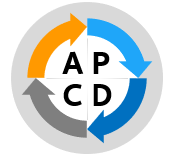
- 5 MINUTES READ
Also known as Shewhart Cycle and Deming Wheel.
Variants include PDSA Cycle and OPDCA.
The Plan-Do-Check-Act Cycle (PDCA Cycle) is a four-step model for systematic problem solving and continuous improvement. It offers a simple and structured way for resolving business-related issues and creating positive change . This framework is widely recognized as the basis for enhancing the quality of processes, products, and services by following a logical sequence of four steps: Plan, Do, Check, and Act.
The PDCA cycle model can be applied in most kinds of projects and improvement activities, whether they are breakthrough changes or smaller incremental enhancements. For example, it can be effectively utilized when aiming to enhance employee skill levels within an organization, change the supplier of a product or service, or increase the quality of care and patient engagement within a hospital.
A common practical example of the PDCA cycle can be illustrated when dealing with customer complaints. This scenario involves steps like reviewing, categorizing, and prioritizing the existing complaints, generating potential solutions for addressing the most frequent complaints, conducting pilot surveys with sample customers to test new options, collecting and analyzing customer data and feedback, and ultimately implementing lessons learned on a larger scale. The above steps represent the PDCA cycle in action.

The Four Phases of the PDCA Cycle
The PDCA cycle begins with the Planning phase which involves the identification of the problem and objectives. During this phase, a collaborative effort is made to agrees on the problem to be solved or the process to be improved. Subsequently, an in-depth analysis of the existing as-is situation is conducted, alternative solutions are identified, and the most promising solution is selected and scheduled for implementation.
In the Do phase, the selected solution is put into action on a limited scale. This phase also involves ongoing progress measurement, data collection, and feedback gathering to facilitate subsequent analyses.
The Check phase involves analyzing the collected data and feedback and comparing the outcome against pre-established objectives. This phase allows to evaluate how well the solution has worked and where further enhancement may be needed. Additionally, it involves the identification of unexpected issues and the gathering of key learnings. It is important to note that the Do and Check phases may need to be repeated until the desired results are achieved.
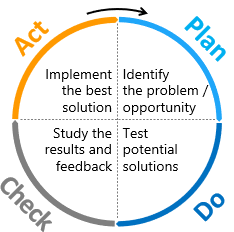
The Act phase is the point at which the chosen solution is fully integrated. This phase requires taking actions based on the insights acquired from the Check phase. A plan for full-scale implementation is carried out, taking into account the associated costs and benefits. The Act phase also concerned with standardizing , documenting, sustaining the improved process, as well as integrating it into the organization’s system.
The utilization of the PDCA cycle doesn’t necessarily stop once the Act phase is completed. The improved process often becomes the new baseline, which may prompt a return to the Plan phase. Multiple iterations of the PDCA cycle may be essential for a permanent resolution of the problem and the attainment of the desired future state. Each cycle brings one closer to their goals and extends their knowledge further.
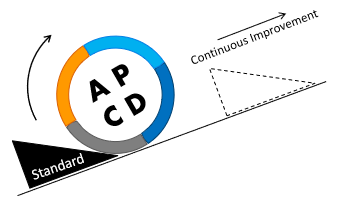
A common example often used to illustrate the PDCA cycle is when a team is initiating a new product development.
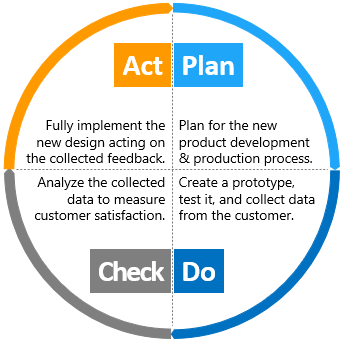
Another example is when a lab team is planning to solve a customer complaint about the delayed test results at a laboratory.

In the 1990s, a modified version of the PDCA cycle was introduced. It was called PDSA cycle where ‘S’ stands for Study. It is believed that data analysis is important for any improvement effort, and “Checking” does not really imply studying and analyzing the data.

OPDCA is another version of PDCA where ‘O’ stands for Observe . The Observe is added at the front of the cycle to emphasize the need to observe before creating any plan. The goal of observation is to find out what is really happening and what can be improved.
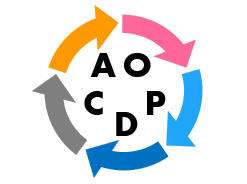
You may find it useful to use the following tools in each phase of the PDCA/PDSA cycle:
- Plan – process mapping , brainstorming, waste analysis , prioritization matrix , improvement roadmap , gap analysis , and force field analysis .
- Do – Gantt chart , dashboard, data collection methods , sampling, observation , check sheet , and control chart.
- Check/Study – graphical analysis , statistical analysis, 5 whys , fishbone diagram , Pareto analysis , root cause analysis, and decision-making techniques .
- Act – process mapping , Gantt chart , dashboard, control chart, control plan, visual management , and standard work .
Several tools are available to aid in planning and monitoring project activities using the PDCA model. One of the most straightforward methods is to use this PDCA template .
Wrapping Up
PDCA represents the logical way of thinking we tend to follow when resolving problems and implementing continuous improvement. The objective is to make significant progress towards achieving the intended goal. Furthermore, it is important to note that the PDCA model stands at the core of almost all quality management systems. TQM, ISO standards and the A3 thinking process are all based around the PDCA philosophy.
Other Formats

Do you want to use the slides in your training courses?
PDCA Training Material – $18.85
Related Articles
Project Charter

Improvement Roadmap

Related Templates
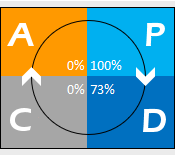
A3 Problem Solving

Kaizen Event Charter
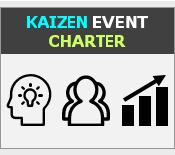
Written by:
CIToolkit Content Team

- Sign Up Free
THE LEAN WAY BLOG
Using the pdca cycle to support continuous improvement (kaizen).
by Nawras Skhmot
5th August 2017
"Plan" is really a three-step process. The first step is the identification of the problem. The second step is an analysis of this problem. The third step is the development of an experiment to test it. Some of the things to consider during this process includes: Problem Identification
- Is this the right problem to work on?
- Is this problem important and impactful for the organization?
- Who does the problem affect and what is the potential impact of solving it?
Problem Analysis
- What is the requisite information needed to fully understand the problem and its root cause?
- What data do we already have related to the problem? What data do we need to collect?
- Who should be enlisted or interviewed to better understand the problem?
- After understanding the problem, is it feasible to solve it? Will the solution be economical and practical?
Developing an Experiment
- What are some viable solutions?
- Who will be involved in the process and who will be responsible for it?
- What is the expected outcome of the experiment and how can we measure performance?
- What are the resources necessary to run a small scale experiment?
- How will the results from the small scale experiment translate to a full-fledged implementation?
The “Do” stage is where we test the proposed solutions or changes. Ideally, this should be carried out on small-scale studies. Small-scale experiments allow us to learn quickly, adjust as needed, and are typically less expensive to undertake. Make sure that you measure the performance and collect the data necessary to make an evaluation later on.
In this stage, review the experiment, analyze the results, and identify what you’ve learned. Consider the following questions:
- Did the implementation of the change achieve the desired results?
- What did not work?
- What was learned from the implementation?
- Is there enough data to show that the change was effective?
- Do you need to run another experiment?
- How does the small scale experiment measure up to the larger picture?
- Is the proposed solution still viable and practical?
In this stage, take action based on what you learned in the study. If the change did not work, go through the cycle again with a different plan. If you were successful, incorporate what you have learned from the test into wider changes. Use what you have learned to plan new improvements and start the cycle again. If your plan worked, you will need to standardize the process and implement it across the business. During this phase of the PDCA cycle, you should ask the following questions:
- What resources are needed to implement the solution company-wide?
- What kind of training is needed for full implementation of the improvement?
- How can the change be maintained and sustained?
- How can we measure and monitor the impact of the solution?
- What are some other areas of improvement?
- How can we use what we have learned in this experiment to devise other experiments?
Using the PDCA Cycle to Support Kaizen
The PDCA process supports both the principles and practice of continuous improvement and Kaizen . Kaizen focuses on applying small, daily changes that result in major improvements over time. The PDCA Cycle provides a framework and structure for identifying improvement opportunities and evaluating them objectively. Using PDCA, an organization undergoing continuous improvement can create a culture of problem solvers and critical thinkers. Improvement ideas can be rigorously tested on a small scale. Using data, the team can make adjustments to the solution and reassess the hypothesis. After an idea has been shown to be effective, it can be standardized and implemented companywide. The iterative process of the PDCA cycle enables ideas to be continuously tested and promotes a continuous improvement and continuous learning culture. Eager to get started? Use The Lean Way to practice PDCA and Continuous Improvement with your team. Get started with a free 14 day trial.
ABOUT THE AUTHOR
Nawras Skhmot, is a Norwegian civil engineer and entrepreneur with an educational background from The Norwegian University of Science and Technology (NTNU) and UC Berkeley. He is currently working on applying Lean Construction in the Norwegian construction industry, in addition to be involved in several startups that aims to develop softwares and applications based on lean thinking.
YOU MIGHT ALSO LIKE...
The 8 wastes of lean, what is muda, mura, and muri, lean culture, 6 tips to starting and sustaining your continuous improvement efforts, continuous improvement, 5 benefits of continuous improvement.
by TickTick
PDCA Cycle Explained: 4 Steps for Continuous Learning and Improvement

The Meaning of PDCA Cycle
PDCA Cycle (also known as PDSA Cycle or Deming Cycle), is a problem-solving method used for the continuous learning and improvement of a process or product.
There are 4 basic steps in PDCA Cycle:
- Plan : identify a problem and possible solutions
- Do : execute the plan and test the solution(s)
- Check : evaluate the results and lessons learned
- Act : improve the plan/process for better solutions
These four steps incorporate inductive-deductive interplay and have been a simple and scientific approach for problem-solving (process-improving). It follows the curve of how we acquire knowledge through constant reflection, standardization, and modification.
The PDCA framework begins with a planning phase where a problem or a process to be improved is identified. This involves not only the goal setting and finding possible solutions, but also hypothesizing methods that can be used to reach the ultimate goal. Another thing that needs special attention is defining the success metrics. This simply means a clear evaluation matrix is ideally to be set beforehand.
Then, the solution(s) will be tested in the Do process. To detach the Do, there could be two steps: making the Do multiple To-Dos by splitting the task and defining them with a specific time, personnel, and steps, and collecting real-time data and feedback.
Check includes analyzing the results and comparing them to the hypothesis in the Plan stage: how well the solution worked, how much the goal has been achieved, and whether the methods were proven feasible. If there are any unexpected issues, you may also need to find the causes and possible solutions. Note that there might be forth and back between Do and check.
The Act step closes the cycle, which involves adjustment on the initial goal or solutions and integration of all key learnings by the entire process, to standardize successful parts and avoid error recurrence. In a nutshell, the Act phase summarizes the current cycle and prepares for the next.
However, the PDCA cycle doesn’t stop here. Instead, it can repeat from the beginning with a modified version of the Plan. There is no end to it and sustainability should be its main pitch.
How PDCA Has Evolved
Usually used interchangeably with “PDSA Cycle”, “Deming Cycle”, “Deming wheel”, “Shewhart Cycle” etc, the PDCA model has indeed confronted some misunderstanding and confusion. It remains unexplained in most cases how PDCA became what it is today and what’s the difference between those mysterious terminologies and how they interact. According to Ronald D. Moen & Clifford L. Norman , its evolution could be summarized like the following:
Shewhart cycle (1939): Specification - Production - Inspection .
He brought up this method from the viewpoint of Quality Control.
Deming Wheel (1950): Design the product - Make the product - Sell it - Test it .
Deming built off the Shewhart cycle and emphasized the four steps should be rotated constantly to aim for the product quality. This has gained increasing popularity when Deming participated in the Japanese Union of Scientists and Engineers (JUSE).
PDCA Cycle (the 1950s): Plan - Do - Check - Act.
A Japanese executive reworked the Deming Wheel and translated it into the PDCA Cycle for problem-solving. PDCA emphasizes more on the establishment of standards during the process and the ongoing modification of those standards.
Extended PDCA Cycle (1985): Plan - Do - Check - Act .
Kaoru Ishikawa refined the PDCA model to include more steps in the Plan and Do steps: Identify the goals and methods to use; involve in training and education during implementation.
PDSA Cycle (1985): Plan - Do - Study - Act .
Deming claimed that the ownership of PDCA Cycle was never recognized by anyone and the word “check” was used incorrectly because it means “to hold back”. Therefore, he replaced it with “study” to emphasize the importance of the continuous learning-improvement model.
How to Implement - PDCA Examples
Now, you’ve got a clear idea of what the PDCA Cycle is and how it changes over time. As a simple and structured method widely adopted in Quality Control and Total Quality Management, can it also be applied in wider areas, such as personal growth and business development? Yes, I’ll give you a couple of examples.
Benefits of PDCA Cycle
Among all those other methods, why does the PDCA model shade some lights in the history, especially known for the “Japanese Quality” and is still widely used today? Some key benefits of it need to be valued.
PDCA methodology emphasizes minimizing errors and maximizing outcomes. When applied to business development, e.g. a product’s iterations, it could ensure a developing path where the product is shaped better and better to the market and customers. It’s the same when it comes to personal growth. It also leaves space for constant check and reflection, which can avoid wasting time on the mistakes or making the same mistakes.
PDCA framework follows a learning curve and enhances the learning-improvement process continually. This is the key factor defining PDCA as a scientific and methodical way to gain knowledge. With knowledge building up, people’s ability goes up.
PDCA model encourages a growth mindset. Seeing continuous improvements is a good way to enhance individuals’ self-esteem levels and bring a great sense of accomplishment. People tend to find meaning in the things they do. Imagine if one stops making progress, they would stay in the static and lose meaning in repetitive work and life.
- PDCA Cycle is a simple and scientific way for problem-solving and process improvement.
- PDCA Cycle involves four key steps: Plan, Do, Check and Act.
- PDCA works slightly differently from Deming Cycle, Shewhart Cycle, and PDSA.
- PDCA Cycle is a never-ending process that can be used on a continual basis.
- PDCA Cycle can be used for quality control, business development, and personal growth.
Related Posts:

Minimalism: How I Finally Found the True Beauty of Living with Less

Steering towards Your Most Important Goals in Work and Life with OKRs

Time Blocking: How It Helps You Take Control of Your Time

- Lean Philosophy
Eight Steps To Practical Problem Solving

The Toyota Way To Problem Solving
The art of problem solving is constantly trying to evolve and be re-branded by folks in various industries. While the new way might very well be an effective method in certain applications. A tried and true way of identifying and solving problems is the eight steps to practical problem solving developed by Toyota, years ago. The system is structured, but simple and practical enough to handle problems of the smallest nature, to the most complex issues.
Using a fundamental and strategic way to solve problems creates consistency within an organization. When you base your results off facts, experience and common sense, the results form in a rational and sustainable way.

The Eight Step Problem Solving Process
- Clarify the Problem
- Breakdown the Problem
- Set the Target
- Analyze the Root Cause
- Develop Countermeasures
- Implement Countermeasures
- Monitor Results and Process
- Standardize and Share Success
The eight steps to practical problem solving also include the Plan, Do, Check and Act (PDCA) cycle. Steps one through five are the planning process. The doing is found in step six. Step seven is the checking . Step eight involves acting out the results of the new standard.
This practical problem solving can be powerful tool to issues facing your organization. It allows organizations to have a common understanding of what defines a problem and what steps are going to be taken in order to overcome the problem efficiently.
The Eight Steps Broken Down:
Step 1: clarify the problem.
A problem can be defined in one of three ways. The first being, anything that is a deviation from the standard. The second could be the gap between the actual condition and the desired condition. With the third being an unfilled customer need.
In order to best clarify the problem, you have to see the problem with your own eyes. This gives you the details and hands-on experience that will allow you to move forward in the process.
Step 2: Breakdown the Problem
Once you’ve seen the problem first hand, you can begin to breakdown the problem into more detailed and specific problems. Remember, as you breakdown your problem you still need to see the smaller, individual problems with your own eyes. This is also a good time to study and analyze the different inputs and outputs of the process so that you can effectively prioritize your efforts. It is much more effective to manage and solve a bunch of micro-problems one at a time, rather than try and tackle a big problem with no direction.
Step 3: Set the Target

Step three is all about commitment and focus. Your attention should now turn towards focusing on what is needed to complete the project and how long it will take to finish. You should set targets that are challenging, but within limits and don’t put a strain on the organization that would hinder the improvement process.
Step 4: Analyze the Root Cause
This is a vital step when problem solving, because it will help you identify the actual factors that caused the issue in the first place. More often than not, there are multiple root causes to analyze. Make sure you are considering all potential root causes and addressing them properly. A proper root cause analysis, again involves you actually going to the cause itself instead of simply relying on reports.
Step 5: Develop Countermeasures
Once you’ve established your root causes, you can use that information to develop the countermeasures needed to remove the root causes. Your team should develop as many countermeasures needed to directly address any and all root causes. Once you’ve developed your countermeasures, you can begin to narrow them down to the most practical and effective based off your target.
Step 6: Implement Countermeasures
Now that you have developed your countermeasures and narrowed them down, it is time to see them through in a timely manner. Communication is extremely important in step six. You’ll want to seek ideas from the team and continue to work back through the PDCA cycle to ensure nothing is being missed along the way. Consider implementing one countermeasure at a time to monitor the effectiveness of each.
You will certainly make mistakes in throughout your problem solving processes, but your persistence is key, especially in step six.
Step 7: Monitor Results and Process
As mistakes happen and countermeasures fail, you need a system in place to review and modify them to get the intended result. You can also determine if the intended outcome was the result of the action of the countermeasure, or was it just a fluke? There is always room for improvement in the problem solving process, but you need to be able to recognize it when it comes to your attention.
Step 8: Standardize and Share Success
Now that you’ve encountered success along your problem solving path, it is time to set the new processes as the new standard within the organization and share them throughout the organization. It is also a good time to reflect on what you’ve learned and address any possible unresolved issues or troubles you have along the way. Ignoring unresolved issues will only lead to more problems down the road.
Finally, because you are a true Lean organization who believes continuous improvement never stops, it is time to tackle the next problem. Start the problem solving process over again and continue to work towards perfection.
Additional Resources
- 8D for Problem Solving – creativesafetysupply.com
- Training to Use 8D Problem-Solving Tactics – blog.creativesafetysupply.com
- The Great Root Cause Problem Solving Debate – realsafety.org
- Design Thinking: Empathy and Iteration for Innovation and Problem-Solving – creativesafetypublishing.com
- 10 Commandments to Continuous Improvement – lean-news.com
- Lean Manufacturing Implementation – The First 5 Steps – iecieeechallenge.org
- The Transitional Steps Involved In The 5s Principles During Implementation – 5snews.com
- “No Problem” is a Problem – jakegoeslean.com
- The Tools of Kaizen – blog.5stoday.com
Related posts:
- 3P and Lean
- The Vacation Paradox
- Why Single Minute Exchange of Die (SMED)?
- Total Quality Management And Kaizen Principles In Lean Management
- An Engaged Employee is a Productive Employee
- Jim Womack’s Top Misconceptions of the Lean Movement
- Muda, Mura, and Muri: The Three Wastes
- Announcements
- Brainstorming
- Development
- HR Planning
- Infographics
- IT & Operations
- Marketing & Sales
- Meeting & Visual Collaboration
- Product Management
- Production & Manufacturing
- Project Management
- Remote Working
- Research & Analysis
- Software Teams
- Strategy & Planning
- Template Roundup
- Uncategorized
How to Use the PDCA Cycle to Speed Up Team Problem-Solving Sessions
Updated on: 28 February 2023
The PDCA cycle is a great tool to help keep your team in line; to help organize their thoughts and actions. Too often many teams tend to go off their course when they are in the early stages of teamwork and know little or nothing about quality improvement. This is where the PDCA Cycle can help.
The PDCA cycle seems fairly easy to understand, but there are many layers to it. In this post, we will cover each step of the plan do check act cycle and provide you with tools that you can use to accelerate the cycle.
Let’s find out how you can use this powerful technique to improve your team problem-solving sessions.
What is PDCA?
The best way to describe the cycle is through a graphic. The cycle flows clockwise through four steps; Plan, Do, Check and Act. And it describes the process a team would follow as they study a process and devise a plan, run a test, check the outcome, and implement it on a full scale.
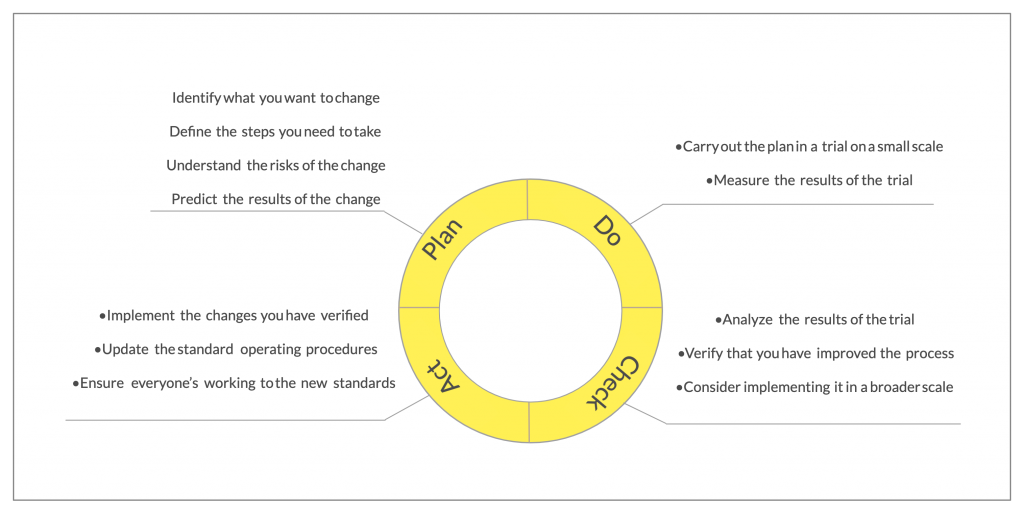
The Plan-Do-Check-Act Cycle is an iterative four-step management method. It can be used by teams to tackle problems and find solutions to them, and to improve business processes. Many organizations use the PDCA model to organize their quality improvement efforts.
One thing you need to remember when using the PDCA cycle is that it is a continuous process as opposed to an end-to-end process, therefore it never ends; the steps need to be repeated again and again for continuous improvement .
Once you have come to the last stage of Act, you need to go right back to the beginning and start all over again. Constantly look for problems, improve the system of production and service, and quality and productivity in order to continuously reduce costs.
An essential part of the lean manufacturing philosophy, it is popularly used as a framework for continuous improvement in management and manufacturing.
The PDCA cycle was originally developed in 1930 by quality expert Walter Shewart – hence also known as the Shewart Cycle. It was later applied to management by Dr. W. Edwards Deming and came to be known as the Deming Cycle.
Benefits of Using the PDCA Cycle
- A problem-solving method that provides a quick way to find an effective solution
- Ensure steady ongoing improvement
- Can be implemented in companies of all sizes and is easy to adapt and implement
- Create an opportunity to constantly monitor the effectiveness of an implemented project
- Detect any risks or problems on time before they lead to any financial losses
- Increase awareness of the employees about the process and the role they play in it.
However, it also involves some disadvantages. The PDCA process requires the involvement of all the individual responsible, which would prove to be quite difficult if they are also involved in other projects. Moreover, it involves multiple steps that range from analysis to testing, therefore it isn’t a great tool for solving urgent problems.
When to use the Plan Do Check Act model
- To carry out a new improvement or change project
- When designing a new product, service, or process
- When planning, implementing and checking compliance
- To track and solve problems
- To implement continuous improvement
- Evaluating a business process related to a specific problem that is being solved
In most organizations, the model is commonly used to implement changes in and improve processes.
How to Use the PDCA Cycle
The PDCA cycle has four stages. We have listed them below along with the steps involved.
Plan – Identify and Analyze the Problem
This step concludes with an actionable plan that can be tested. To do so, you need to first identify the problem along with the process that needs to be improved.
- Select, define and describe the process; start, end, the sequence of steps in between, what it does, the people involved, equipment material and resources that are used, and environmental conditions.
- Identify the key players; internal and external customers, suppliers, process owners, and operators
- Understand customer expectations; identify the specific needs of both external and internal customers. What do they want, when, where, in which quantities, etc.
- Research; look at the historical data available on the process to understand its performance and identify further data you will need to understand the process properly
- Specify the problem associated with the process; for example, it could be caused by failing to meet customer expectations, longer cycle time, lack of resources, etc.
- Identify the root cause; brainstorm around the problem to find its primary causes
- Find a solution: Develop solutions that can be applied to improve the process. Prioritize solutions based on their effectiveness.
- Develop the action plan: Identify the steps you need to carry out to implement the plan, the resources you need, the people who are responsible as well as set a timeframe
Here are some tools you can use in this step,
- Flowchart/ process maps; flowcharts can be used to visualize the process and provide a quick overview of the flow of steps from start to end. Add swimlanes , and you can also highlight different departments or owners involved.
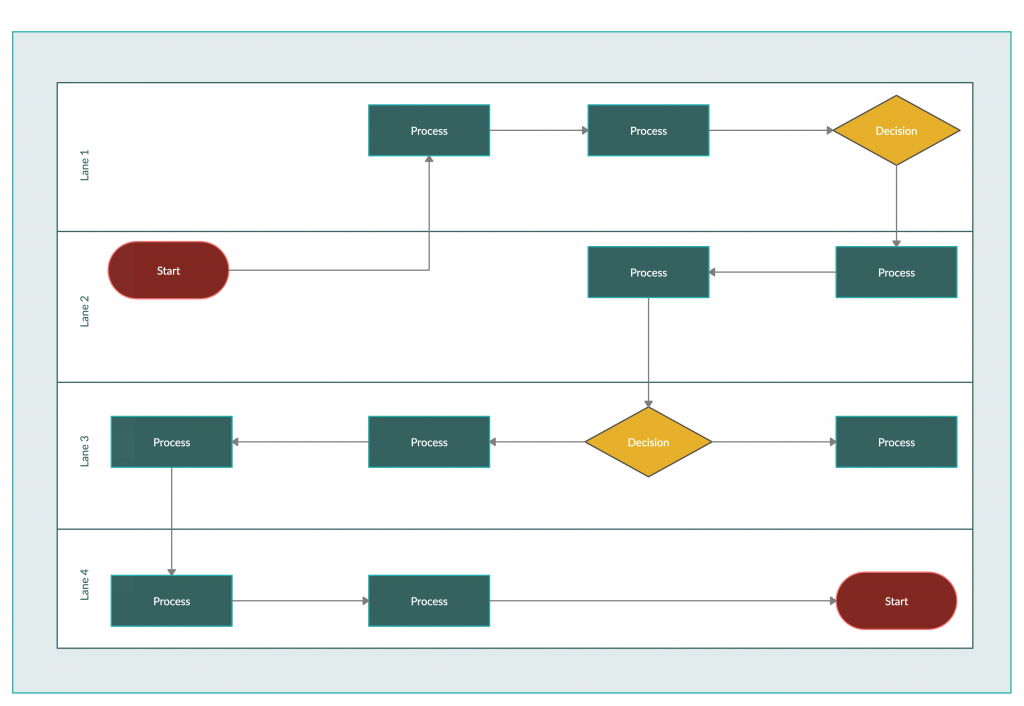
- Affinity diagram; this tool helps categorize all the data you gather from research, surveys, feedback, conversations, etc. By doing so you will be able to understand any themes in the data that might be useful when finding a solution.

- Cause and effect diagram; this tool comes in handy when you and your team have to brainstorm around the problem to identify its primary causes.

- Impact effort matrix; when prioritizing solutions, you can use the impact effort matrix to prioritize solutions based on the effect they have and the effort it would take.
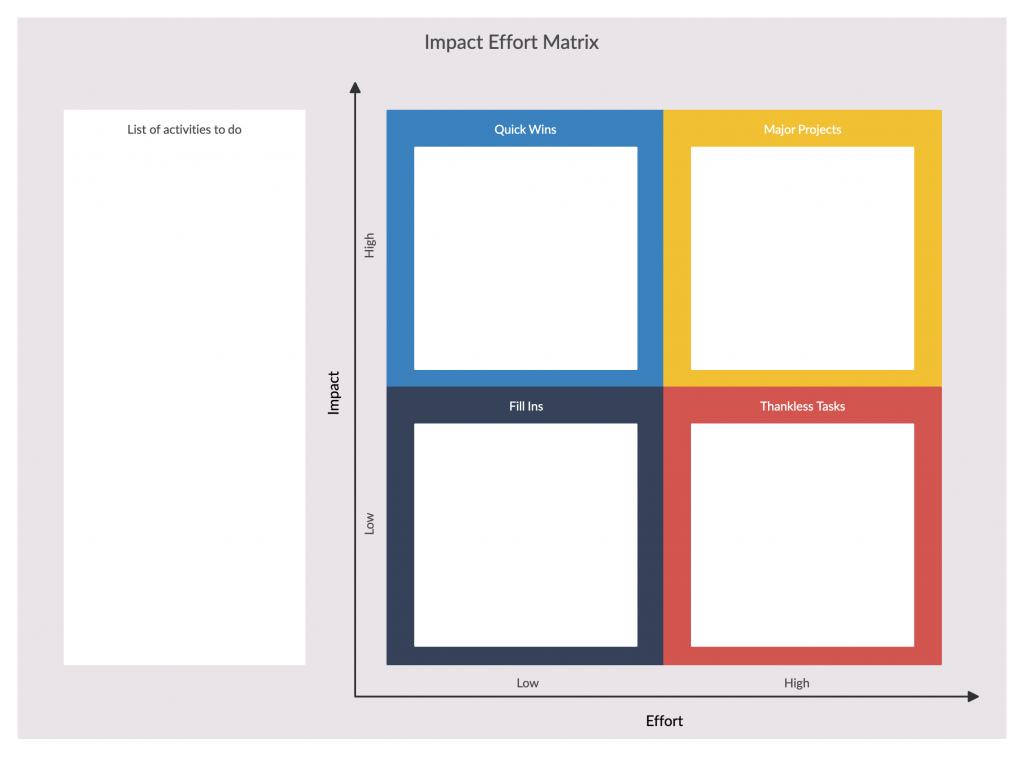
- Action Plan: use this to quickly identify and communicate the key tasks, needed personnel, resources and the timeframe for the plan to the rest of the team
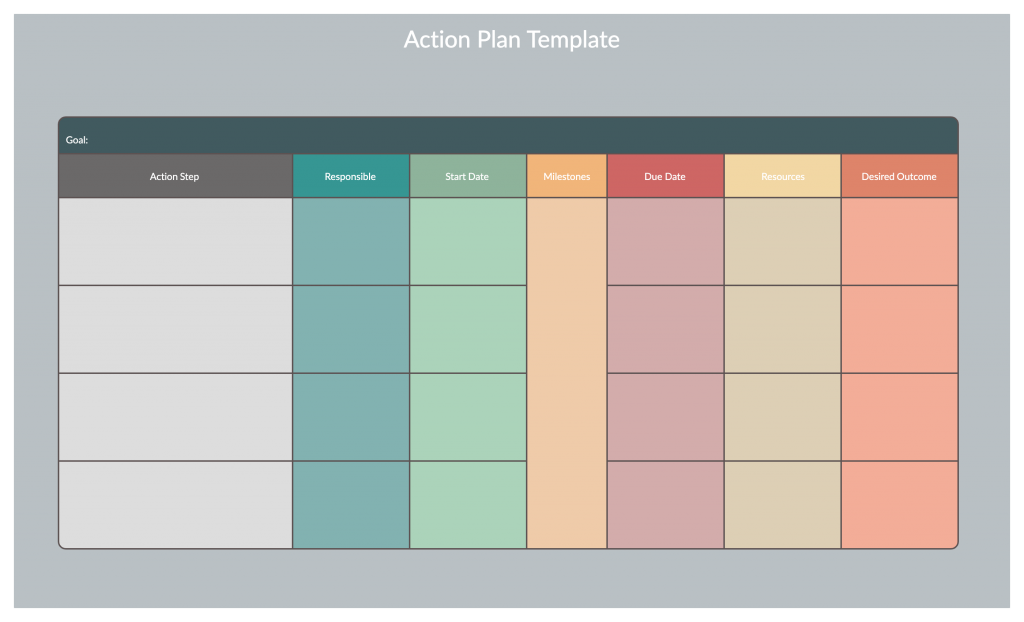
Do – Develop Solutions and Implement Plan
The plan devised in the first step is put to test in this stage.
The trial should be run on a small scale with the customers, in a laboratory or in a production setting. By implementing a small pilot project to observe the results first helps identify mistakes without having to bear huge a cost of an entirely failed project.
It’s equally important to have specified measures you can use to understand how effective is the solution you selected in eliminating the identified problem.
Check – Evaluate the Results
The team checks the results of the test plan in motion. Has the performance of the process improved? Has the group of customers noticed the change?
As you collect data from the test plan, identify what has worked and what has not gone according to plan.
Analyze the data and measure the results to determine if the selected solution can be implemented on a large scale. If the solution hasn’t been as effective as you thought, you will have to devise a plan for another solution and repeat the Do and Check steps again.
Act – Use Feedback to Improve and Replan
In this step, the full implementation of the plan is accomplished. Apply the improvements you discovered during the test to the plan before implementing it.
- Educate the rest of the organization about the improved plan and its importance
- Provide the necessary training to the employees in order to help them modify their job roles
- Standardize procedures to ensure that everyone uses the same format when conducting a procedure
- Put in place a process to monitor and control the implementation of the modified process
Here you can re-do your current state flowchart from step one to show the new and improved process.

Ready to Plan, Do, Check, Act?
The Deming Cycle or the PDCA cycle is a great tool for guiding the improvement activities of an organization. The steps illustrated above are fairly easy to follow, and you’ll generate effective results if you stick to the them.
Got anything to share with us, let us know in the comments section below.
Join over thousands of organizations that use Creately to brainstorm, plan, analyze, and execute their projects successfully.

More Related Articles
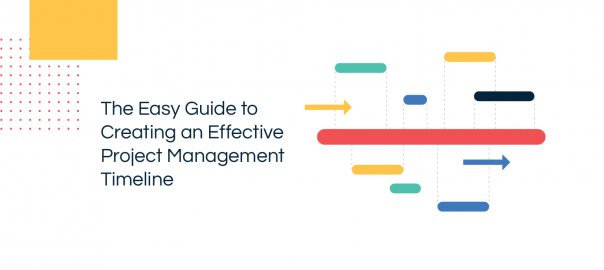
Leave a comment Cancel reply
Please enter an answer in digits: 1 × 1 =
Download our all-new eBook for tips on 50 powerful Business Diagrams for Strategic Planning.
The PDCA Cycle: A Practical Approach to Problem-Solving
PDCA (Plan-Do-Check-Act) is a problem-solving iterative method for improving processes and products continuously. Let’s discover each stage of the PDCA cycle and the benefits it will bring to your processes.
- What Is Lean Management?
- The 5 Principles of Lean
- What Is Shared Leadership?
- What Is Lean Manufacturing?
- What Is Value in Lean?
- 7 Wastes of Lean
- What Is Mura?
- What Is Muri?
- What Is 5S?
- What Is the Cost of Delay?
- What Is Value Stream Mapping?
- What Is a Pull System?
- What Is a Bottleneck?
- Just-in-Time Manufacturing
- Implementing a Kanban Pull System
- Pull System on the Portfolio Level
- What Is Kaizen?
- What Is Continuous Improvement?
- Built-In Quality Management
- What Is the Poka-Yoke Technique?
- What Is the PDCA (Plan Do Check Act) Cycle?
5 Whys: The Ultimate Root Cause Analysis Tool
Gemba Walk: Where the Real Work Happens
- A3 Problem-Solving: Fight the Root Cause
- How To Perform Root Cause Analysis?
- Root Cause Analysis Tools
- What Is a Pareto Chart?
- What Is a Scatter Diagram?
- What Is a Fishbone Diagram?
- What Is Hoshin Kanri?
- What Is Hoshin Kanri Catchball?
- Demystifying the Hoshin Kanri X Matrix
- The Lean Transformation Model Explained
- Lean Transformation Roadmap - 8 Comprehensive Steps
- What Is Cycle Time?
- What Is Little's Law?
- What Is Takt Time?
- What Is Heijunka?
- What Is Jidoka?
- What Is Andon?
- Lean Six Sigma Principles
- Lean Six Sigma Tools
- Lean Six Sigma Implementation
- What Is Six Sigma?
- What Is DMADV?
- What Is DMAIC?
- Lean Project Management
What Is the PDCA (Plan-Do-Check-Act) Cycle?
Explained briefly, the Plan-Do-Check-Act cycle is a model for carrying out change. It is a simple four-stage method that enables teams to avoid recurring mistakes and improve processes. It is an essential part of the Lean manufacturing philosophy and a key prerequisite for continuous improvement of people and processes.
First proposed by Walter Shewhart and later developed by William Deming, the PDCA cycle became a widespread framework for constant improvements in manufacturing, management, and other areas.
Now that we've explained the PDCA's meaning let’s explore the topic further and learn more about this problem-solving model.
Brief History of PDCA
The American statistician and physicist Walter Shewhart is considered the father of PDCA. He was passionate about statistical analysis and quality improvement, and he built the foundation of PDCA recorded in numerous publications.
At first, he developed a 3-step repeating cycle for process improvement also known as "the Shewhart cycle". The three phases of this cycle were:
Years later, inspired by Shewhart’s ideas, William Deming expanded the model into a learning and improvement cycle consisting of the following steps:
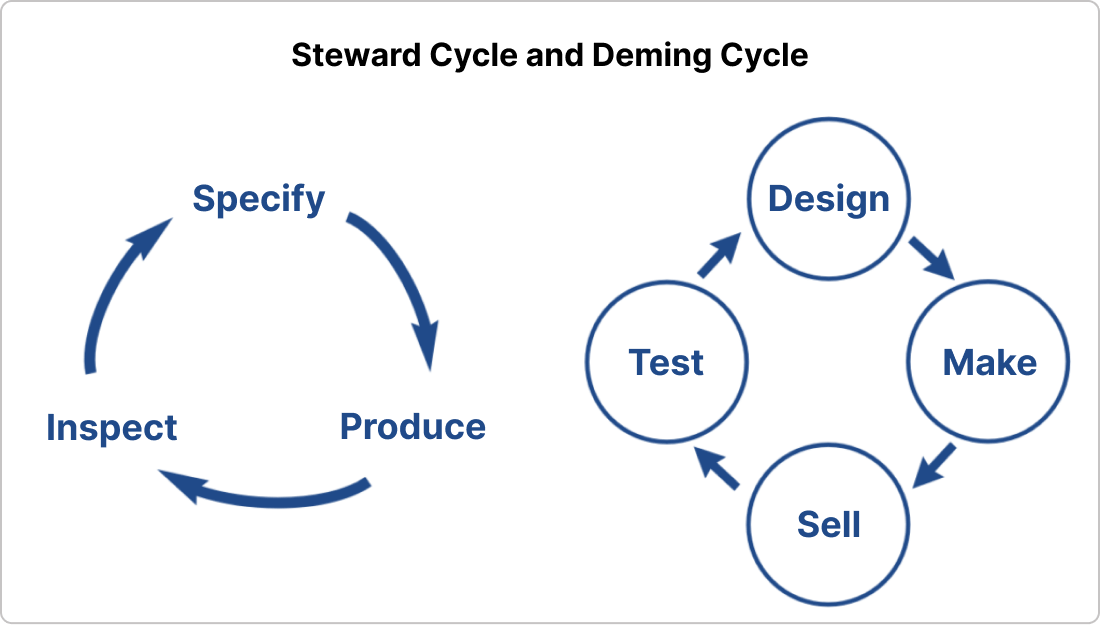
This model was redesigned by the Japanese Union of Scientists and Engineers (JUSE) in 1951 and became what we know today as a PDCA cycle.
What Are the 4 Steps of the PDCA Cycle?

PDCA cycle is an iterative process for continually improving products, people, and services. It became an integral part of what is known today as Lean management . The Plan-Do-Check-Act model includes solutions testing, analyzing results, and improving the process.
For example, imagine that you have plenty of customer complaints about the slow response rate of your support team. Then you will probably need to improve the way your team works to keep customers satisfied. That is the point where PDCA comes into play.
Let’s take a closer look at the four stages of the PDCA process.
Step 1. PLAN
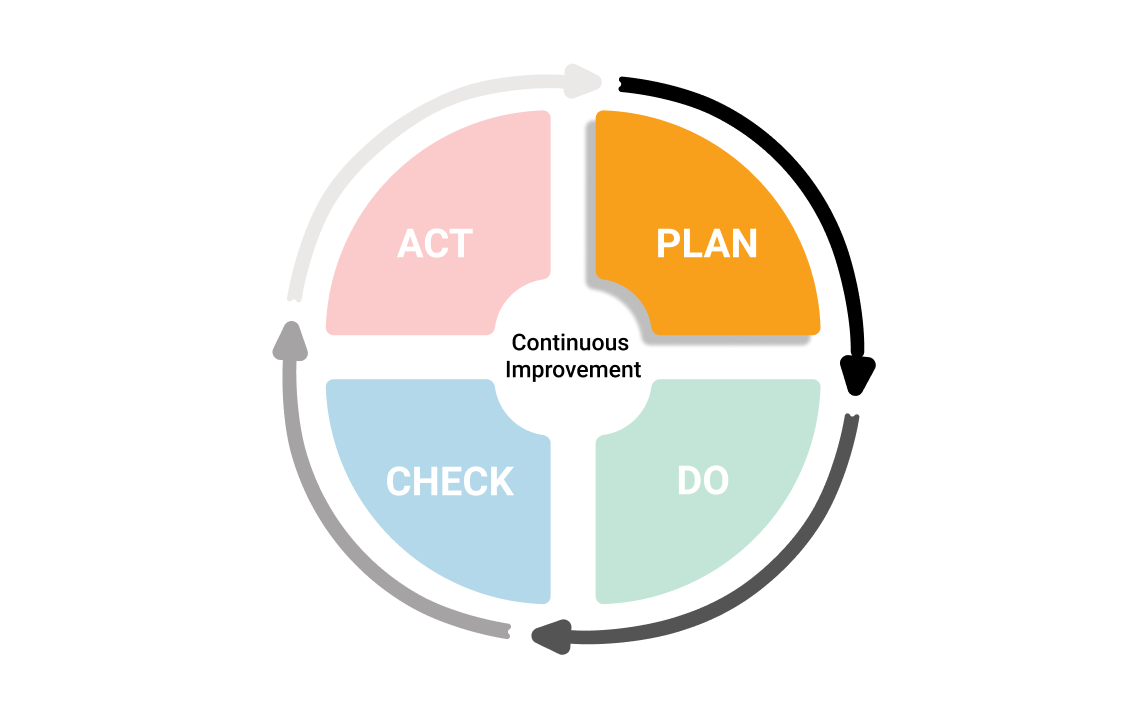
At this stage, you will literally plan what needs to be done. Depending on the project's size, planning can take a major part of your team’s efforts. It will usually consist of smaller steps so that you can build a proper plan with fewer possibilities of failure.
Before you move to the next stage, you need to be sure that you answered some basic concerns:
- What is the core problem we need to solve?
- What resources do we need?
- What resources do we have?
- What is the best solution for fixing the problem with the available resources?
- In what conditions will the plan be considered successful? What are the goals?
Keep in mind you and your team may need to go through the plan a couple of times before being able to proceed. In this case, it is appropriate to use a technique for creating and maintaining open feedback loops, such as Hoshin Kanri Catchball . It will allow you to collect enough information before you decide to proceed.
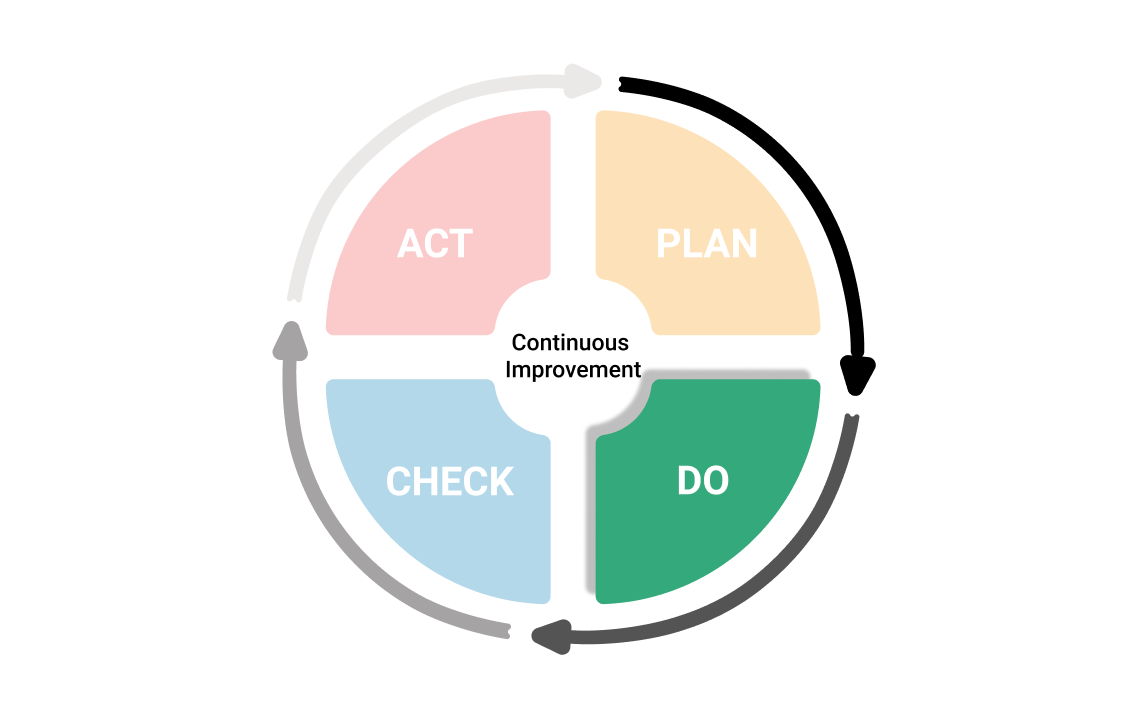
After you have agreed on the plan, it is time to take action. At this stage, you will apply everything that has been considered during the previous stage.
Be aware that unpredicted problems may occur at this phase. This is why, in a perfect situation, you may first try to incorporate your plan on a small scale and in a controlled environment.
Standardization is something that will definitely help your team apply the plan smoothly. Make sure that everybody knows their roles and responsibilities.
10 Years Kanban Experience In 1 Free Book.
Project Manager's Guide to Kanban
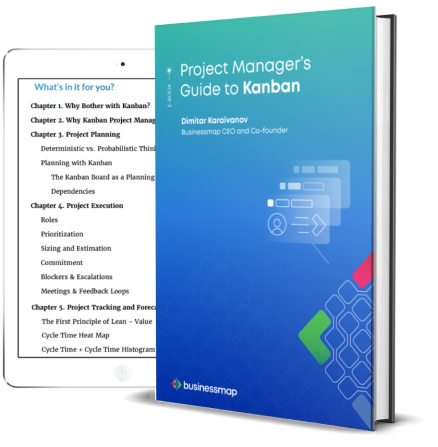
Step 3. CHECK

This is probably the most important stage of the PDCA cycle. If you want to clarify your plan, avoid recurring mistakes, and apply continuous improvement successfully, you need to pay enough attention to the CHECK phase.
This is the time to audit your plan’s execution and see if your initial plan actually worked. Moreover, your team will be able to identify problematic parts of the current process and eliminate them in the future. If something goes wrong during the process, you need to analyze it and find the root cause of the problems.
Step 4. ACT
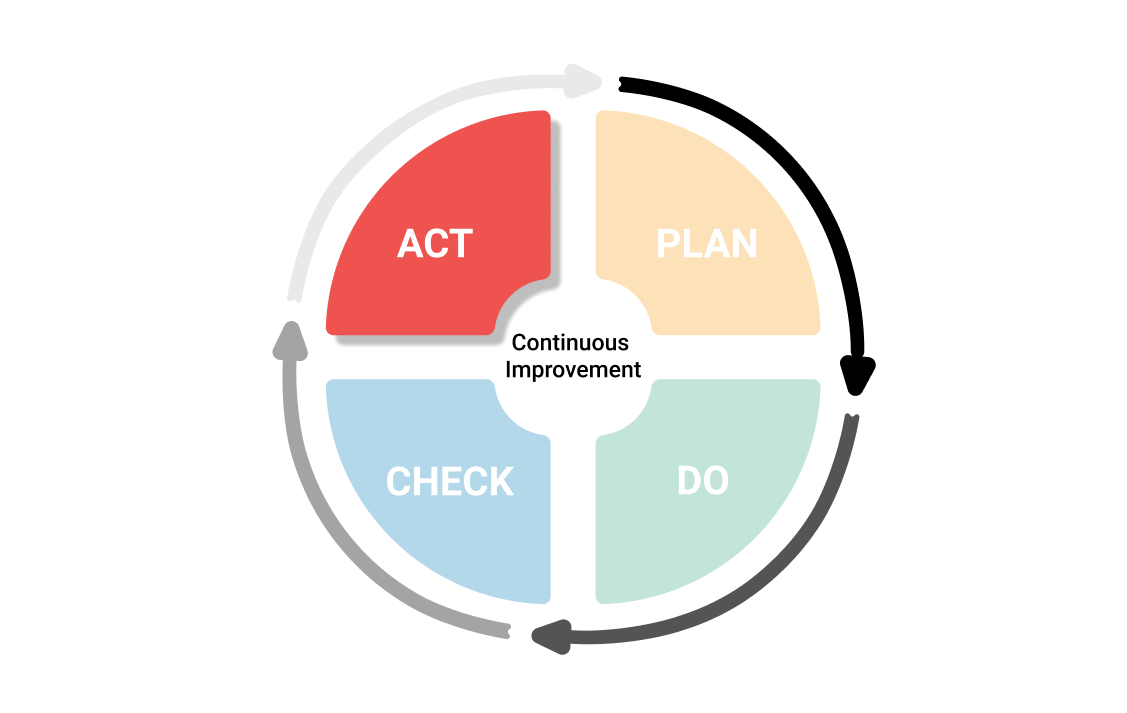
Finally, you arrive at the last stage of the Plan-Do-Check-Act cycle. Previously, you developed, applied, and checked your plan. Now, you need to act.
If everything seems perfect and your team managed to achieve the original goals, then you can proceed and apply your initial plan.
It can be appropriate to adopt the whole plan if objectives are met. Respectively, your PDCA model will become the new standard baseline. However, every time you repeat a standardized plan, remind your team to go through all steps again and try to improve carefully.
Implementing the PDCA Cycle: Best Practices to Consider
Implementing the PDCA (Plan-Do-Check-Act) cycle effectively requires attention to detail and a structured approach. To get the most out of it, there are a few good practices to follow for each stage and overall. Let’s briefly review them. Strong Planning Foundation Identify the process you want to improve and outline the problems that need to be solved. Once defined, set clear SMART goals to guide your team and ensure focus and consistency. Gather data to support the planning process, ensuring decisions are based on evidence rather than assumptions. You can use tools like root cause analysis, fishbone diagrams, and SWOT analysis to understand the problem and its context. Lastly, involve all key stakeholders in the planning process to gather diverse viewpoints and ensure buy-in. Effective Do Stage To minimize risks, test the proposed changes on a small scale before rolling them out company-wide. Ensure that you have all necessary resources, including time, budget, and, most importantly, people, to effectively implement the planned changes and achieve desired results. Consistent Check Phase Don’t just collect data; analyze it. Define critical for your process metrics to measure the impact of the implemented changes and whether they are delivering the expected results. Actionable Act Stage If the changes are successful, document and integrate the new standard operating procedures into regular workflows. If the changes did not meet expectations, analyze why they failed and what can be improved. Either way, as the PDCA cycle is an iterative method, don’t solely rely on the learnings from this one-time round. Apply the most critical outcomes in the next session to enhance operational performance and refine the approach each time. Bonus Tips:
- Ensure top-level management support.
- Share lessons learned with all employees.
- Don’t stop after the first run of the cycle. Instead, install it as a recurring task in your team and organization’s operations for continuous improvement of your processes.
- Leverage digital tools and software to facilitate data collection, analysis, and tracking of PDCA cycles.
Why Is PDCA Important for Your Business?
The PDCA methodology is widely used for problem-solving and to create quality process improvements. By deploying this model, organizations aim to enhance their internal and external processes by eliminating any issues along the way of the work process.
The cyclical nature of this model allows teams to identify and remove defects early in the process and restart the cycle until the desired outcome is reached. This increases efficiency and eliminates ineffective elements until the optimal solution can be identified.
Because of the continuous approach of PDCA, organizations can use this model to gather relevant information before considering whether to progress with a plan or make improvements. This data-driven approach provides a ground basis for organizations’ continuous improvement of processes, products, services, and people.
When to Use the PDCA Cycle?
A specific characteristic of PDCA is that it is relatively versatile. This trait of the cycle allows it to be used across various businesses, organizations, departments, and even individual teams. There is no limitation in terms of its implementation, and it could be applied in the following scenarios:
- Developing a new product or service
- Optimizing current processes or products
- Kicking off a new process improvement project
- Exploring new opportunities for continuous improvement
- Implementing change
- Detecting process issues and working toward removing them
Real-Life Examples of Companies Using PDCA
Example #1: nestlé .
Reducing waste in all aspects of work is an all-time mission for Nestlé. To respond to this message, the company successfully rolled out the concept of Lean management. Furthermore, they introduced the Kaizen method to make sure that everyone in the company meets the idea of continuous improvement. Following the principle of Kaizen that every slight improvement should be made to increase efficiency and reduce costs, the company implemented the PDCA cycle to provide guidelines. (Source: reverscore.com )
In addition, Nestlé Waters is an example of how techniques such as Value Stream Mapping (VSM) can help illustrate the flow of materials and information from raw material to the final product. As a result of implementing this process, the bottling plant has experienced a significant increase in its process efficiency.
Example #2: Lockheed Martin
Lockheed Martin operates in the aerospace industry and is a bright example of how the Kaizen methodology brings results to a company's operations. Implementing the PDCA cycle has standardized the projects and increased the quality of the products and services by targeting a problem and solving it through multiple iterations. Improvements were noticed in the period 1992-1997 when the company made 38% reduction in manufacturing costs, 50% reduction in inventory, and a reduction in delivery time from 42 to 21.5 months. (Source: 6Sigma.com )
Example #3: Nike
Nike embraced Lean manufacturing with the belief that this continuous improvement philosophy is the foundation of their advanced sustainable manufacturing and empowering their workforce. To improve the quality of work conditions and deliver the highest-quality product while eliminating non-value-added activities, Nike implemented the PDCA cycle as part of their process improvement training. (Source: OpEx Learning )
Continuously Improving through PDCA
The PDCA cycle is a simple but powerful framework for fixing issues on any level of your organization. It can be part of a bigger planning process, such as Hoshin Kanri .
The repetitive approach helps your team find and test solutions and improve them through a waste-reducing cycle.
The PDCA process includes a mandatory commitment to continuous improvement, and it can have a positive impact on productivity and efficiency.
Finally, keep in mind that the PDCA model requires a certain amount of time, and it may not be appropriate for solving urgent issues.
What Makes the PDCA Cycle Different from Other Change Management Methods?
What is the difference between pdca and six sigma .
Six Sigma is a quality and process improvement approach that provides organizations with a set of tools and techniques to improve work performance and increase the quality of products and services. One of the tools included in that toolset is the PDCA cycle. While Six Sigma provides the framework for determining what is slowing the process, methods like PDCA explain the steps to identify and eliminate issues.
What Is the Difference between PDCA and PDSA?
PDCA stands for "Plan-Do-Check-Act", whereas PDSA is for "Plan-Do-Study-Act". Even though these two 4-step models are designed to bring improvements into processes, the difference between them is one stage in each cycle.
At the "Check" stage in PDCA, the team needs to audit its plan’s execution and see if its initial plan worked. In contrast, the "Study" stage in PDSA aims to analyze in depth the results of any change applied at each step, ensuring long-term process improvements. Either way, you can use both models by studying and checking the results obtained from tests.
What Is the Difference between PDCA and Kaizen?
Both PDCA and Kaizen strive for continuous improvement through small, incremental changes and creating an organizational culture of Lean thinkers and problem-solvers. The developed Kaizen methodology includes doing small experiments and monitoring results, then adjusting when new improvements are suggested. To apply this concept in practice, the PDCA cycle provides a framework to promote improvements continuously.
What Is the Difference between PDCA and Total Quality Management (TQM)?
TQM is a broader management approach focused on long-term success through customer satisfaction and employee engagement. It is applied organization-wide and requires a cultural shift, where quality becomes a core value. TQM incorporates various tools and methods, including the PDCA's philosophy.
Businessmap is the most flexible software platform
for outcome-driven enterprise agility.
Related Articles
- What Is OKR?
- 5 Whys : The Ultimate Root Cause Analysis Tool
- Best OKR Software Tools
- Value Stream Mapping
- A Guite to Holding an Effective Stand-up Meeting
- OKR vs. KPI
- OKR Templates
- Continuous Improvement Tools

Pavel Naydenov
Head of Marketing | Kanban | PPM Ops Certified
Pavel is a natural-born optimist with 10+ years of experience in the marketing field. By leveraging Kanban, Lean, and Agile practices for years, he drives brand growth and engagement through data-driven marketing strategies. He believes every message should express the fundamental values of a brand, and if delivered positively, it can change the course of its existence.
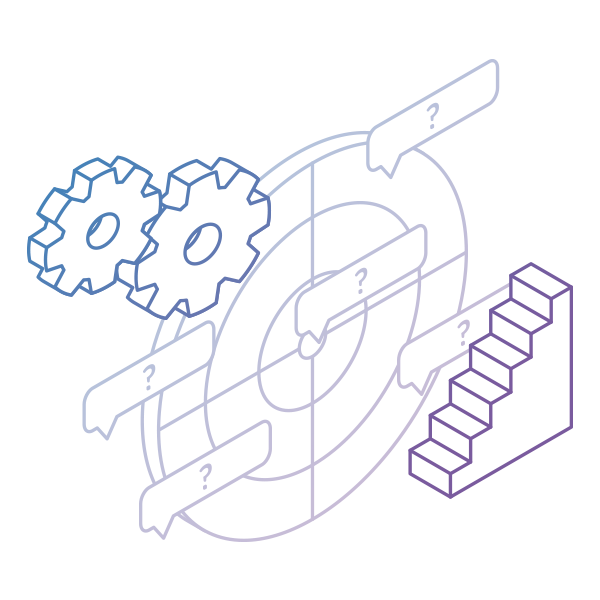
Start your free trial now and get access to all features.
During the 14-day trial period you can invite your team and test the application in a production-like enviroment.

PDCA (Plan-Do-Check-Act)
Dr. w. edwards deming used a four step process, which is more of a cycle – – plan, do, check, act for process improvement. the idea in the plan step is to define the process to improve. the do step is implementing the plan and measuring its performance. the team then takes those measurements to assess whether they are getting the desired results. this is known as the check step. the act step follows. the team decides on changes that need to be made to improve the process; then, the whole cycle starts again..
Over the past few decades there have been a few models for process improvement. Some have used a seven-step problem solving process. Others have used an eight-step problem solving process. Six Sigma typically uses a five-phased approach – DEFINE, MEASURE, ANALYZE, IMPROVE, CONTROL (known as “ DMAIC ”). Dr. W. Edwards Deming used a four-step process, which is more of a cycle – PLAN, DO, CHECK, ACT for process improvement.
The idea in the PLAN step is to define the process to improve. The DO step is implementing the plan and measuring its performance. The team then takes those measurements to assess whether they are getting the desired results. This is known as the CHECK step. The ACT step follows. The team decides on changes that need to be made to improve the process; then, the whole cycle starts again.
Use: This continuous improvement cycle approach is still popular today – especially in Lean implementation . Both DMAIC and PDCA approaches are seeking the same thing – continuous, ongoing, relentless improvements. Some argue that one approach is better than the other. It is this author’s opinion that is better for the team to pick one approach and stick with it than to attempt to pick the best of various models. The ‘water gets muddy’ if it team tries to combine various methods. Don’t get hung up on Six Sigma having to follow the DMAIC model. If the team feels more comfortable with the PDCA approach, that’s fine. Later Deming changed the model to PDSA (PLAN, DO, STUDY, ACT) because he felt that the word ‘study’ was more descriptive than the word ‘check’.

IMAGES
VIDEO
COMMENTS
The 8 Steps and the Problem-Solving Process. The Culture of Problem-Solving. Plan, Do, Check, Act (PDCA) Gain Problem-Solving Support. As a manufacturing professional, you know how important it is to stay organized, keep your goals in mind and strive for success. But with all of the responsibilities and daily tasks piling up, it takes effort to ...
Problem Solving / PDCA IBM Vermont The 8 Step PDCA Cycle - A Closer Look 8 7 6 5 4 3 2 1 Identify & Describe the Problem Team formation, Problem and Goal Statements. Describe the problem. Contain the Problem Perform short term & temporary actions Analyze the Problem Analyze the data and conduct Experiments to prove the true root cause (s).
The PDCA cycle, standing for Plan-Do-Check-Act, is a four-step management method used for continuous improvement of processes and products. It encourages systematic problem solving and iterative optimization.
The 8 Steps to Problem Solving Method was developed by Toyota as a practical, structured, and simple way to handle any problem from the smallest issue to the most complex roadblock. ... Do, Check, and Act (PDCA) cycle. Steps one through five are part of the planning process, step six is the doing process, step seven is the checking process, and ...
It's like a four-step dance for making things work smoothly. The PDCA cycle is an improvement cycle that involves four steps: Plan, Do, Check, and Act, to help improve any business process or task. If you want to make your work more organized or solve problems more efficiently, the PDCA cycle can be your go-to tool.
These people will have to take care of the responsibility and they have to be able to propose and implement the correct solutions. 2: Define the problem. The next step is to obtain a detailed description of the problem. For this, you can use other quality tools as The 5 Whys (what, when, who, where and how). 3: Implement provisional containment ...
The PDCA cycle has four stages: Plan — determine goals for a process and needed changes to achieve them. Do — implement the changes. Check — evaluate the results in terms of performance. Act — standardize and stabilize the change or begin the cycle again, depending on the results. PDCA is the foundation of continuous improvement or kaizen.
Practical PDCA Approach. Practice the 8 steps of Problem Solving and the concepts used at each step. Share & Learn. Work & discuss in teams with participants from different industries. Shop Floor Activities. Practice the methodology working in real processes and problems. TRAINING DETAILS. BENEFITS.
Key Points. The PDCA/PDSA cycle is a continuous loop of planning, doing, checking (or studying), and acting. It provides a simple and effective approach for solving problems and managing change. The model is useful for testing improvement measures on a small scale before updating procedures and working practices.
The PDCA (Plan-Do-Check-Act) cycle is an interactive problem-solving strategy to improve processes and implement change. The PDCA cycle is a method for continuous improvement. Rather than representing a one-and-done process, the Plan-Do-Check-Act cycle is an ongoing feedback loop for iterations and process improvements.
PDCA (Plan, Do, Check, Act) is a four-step methodology for continuous improvement and problem solving in a variety of organizational processes. It starts with planning (Plan) a change or solution, then doing (Do) it on a small scale. The results are then evaluated (Check) to determine the effectiveness of the plan, leading to the final action ...
Plan-Do-Check-Act Cycle (PDCA) is a four-step, iterative by-design method used for control and continual improvement of processes and products. It is also known as the Plan-Do-Study-Act (PDSA) cycle, Deming cycle, Control Circle/Cycle or the Shewhart cycle. The PDCA cycle (Image source: Shutterstock [1]) PDCA is an evidence-based participatory ...
The 8D problem-solving methodology is structured into eight steps, providing a systematic approach to identifying, solving, and preventing problems. The steps include: D1: Form a Team. D2: Define the Problem. D3: Develop Interim Containment Actions. D4: Identify the Root Cause. D5: Choose Permanent Corrective Actions.
The Plan-Do-Check-Act Cycle (PDCA Cycle) is a four-step model for systematic problem solving and continuous improvement. It offers a simple and structured way for resolving business-related issues and creating positive change.This framework is widely recognized as the basis for enhancing the quality of processes, products, and services by following a logical sequence of four steps: Plan, Do ...
The Plan-do-check-act cycle (Figure 1) is a four-step model for carrying out change. Just as a circle has no end, the PDCA cycle should be repeated again and again for continuous improvement. The PDCA cycle is considered a project planning tool. Figure 1: Plan-do-check-act cycle. When to use the PDCA cycle.
Afterwards we will discuss how the PDCA cycle can support Kaizen and continuous improvement. Plan "Plan" is really a three-step process. The first step is the identification of the problem. The second step is an analysis of this problem. The third step is the development of an experiment to test it.
PDCA Cycle is a simple and scientific way for problem-solving and process improvement. PDCA Cycle involves four key steps: Plan, Do, Check and Act. PDCA works slightly differently from Deming Cycle, Shewhart Cycle, and PDSA. PDCA Cycle is a never-ending process that can be used on a continual basis. PDCA Cycle can be used for quality control ...
The eight steps to practical problem solving also include the Plan, Do, Check and Act (PDCA) cycle. Steps one through five are the planning process. The doing is found in step six. Step seven is the checking . Step eight involves acting out the results of the new standard. This practical problem solving can be powerful tool to issues facing ...
Step 2. Confirm the suspected causes of the problem. Step 3. For the confirmed causes. of the problem, do a 5 Why for each one of the causes. Remember, you are still on the planning part of the PDCA process, it is recommended to spend 70% of the 8-Step Problem Solving time on the plan section (Steps 1 to 5).
The cycle flows clockwise through four steps; Plan, Do, Check and Act. And it describes the process a team would follow as they study a process and devise a plan, run a test, check the outcome, and implement it on a full scale. The Plan-Do-Check-Act Cycle is an iterative four-step management method. It can be used by teams to tackle problems ...
Step 1. PLAN. PLAN stage of PDCA cycle. At this stage, you will literally plan what needs to be done. Depending on the project's size, planning can take a major part of your team's efforts. It will usually consist of smaller steps so that you can build a proper plan with fewer possibilities of failure.
Dr. W. Edwards Deming used a four step process, which is more of a cycle - - PLAN, DO, CHECK, ACT for process improvement. The idea in the PLAN step is to define the process to improve. The DO step is implementing the plan and measuring its performance. The team then takes those measurements to assess whether they are getting the desired results. This is known as the CHECK step. The ACT ...